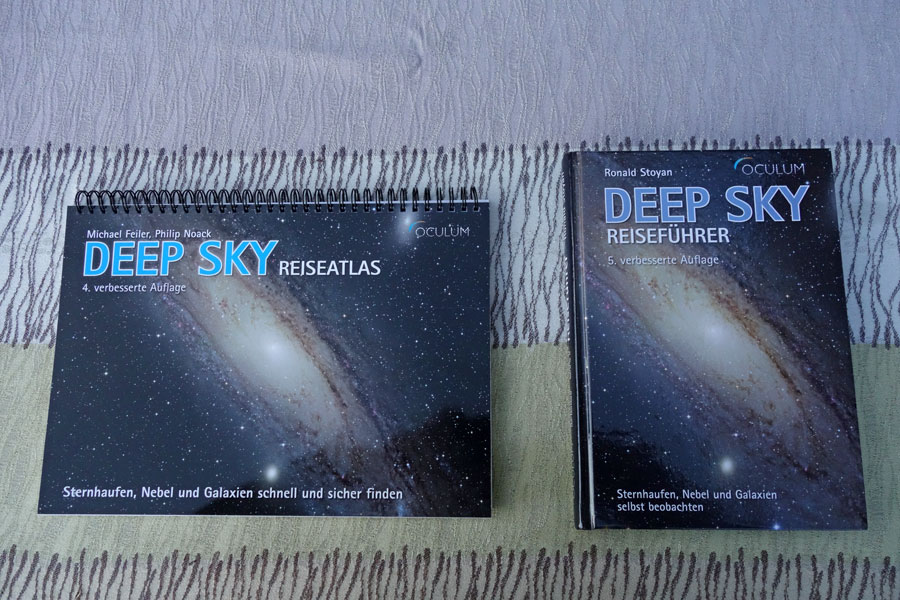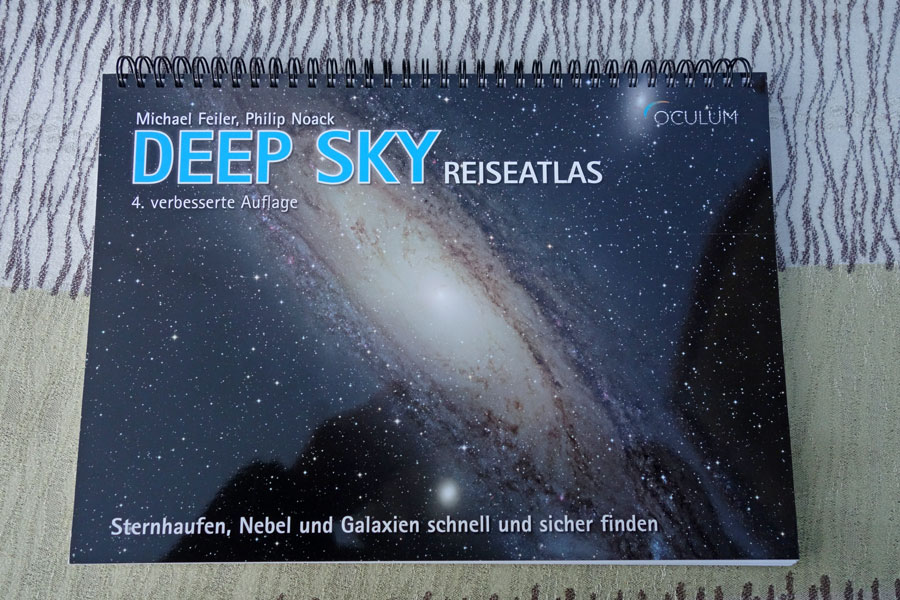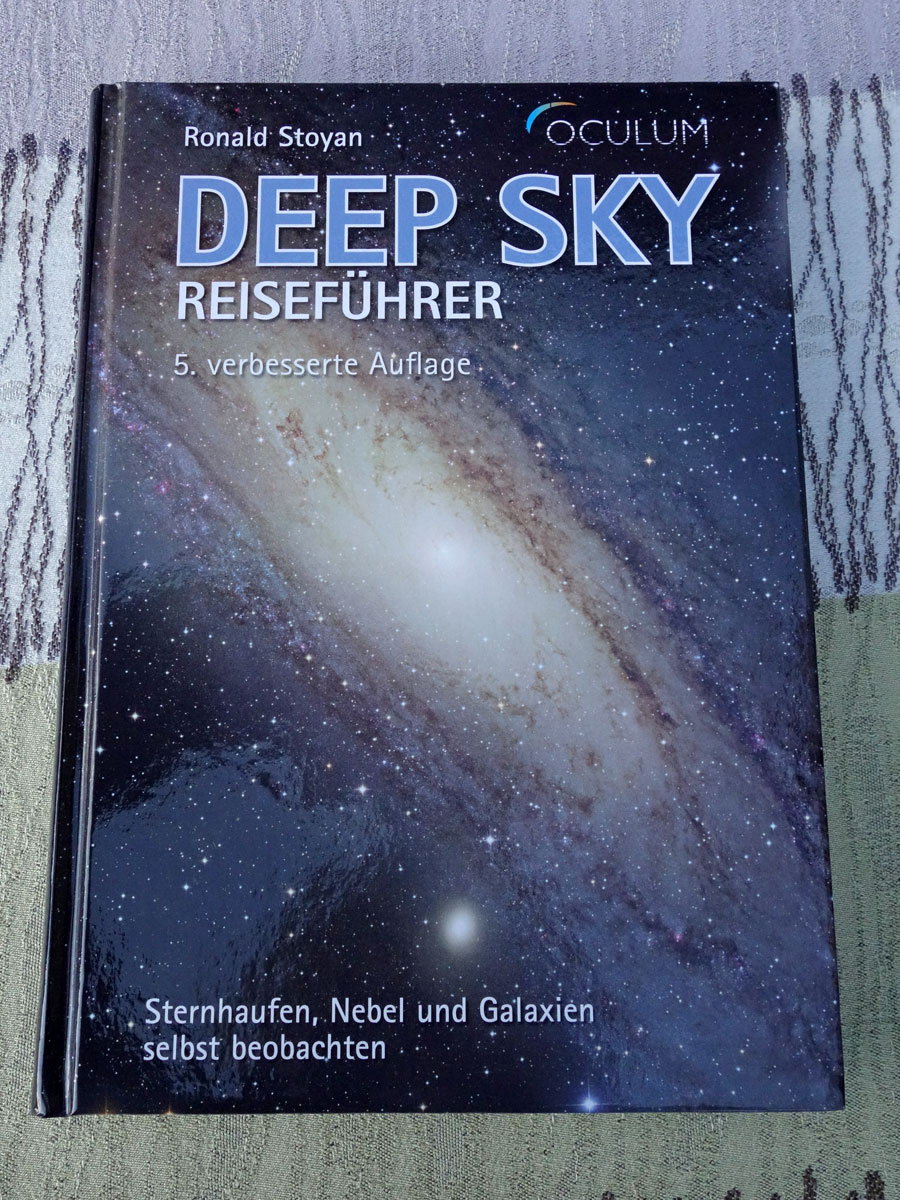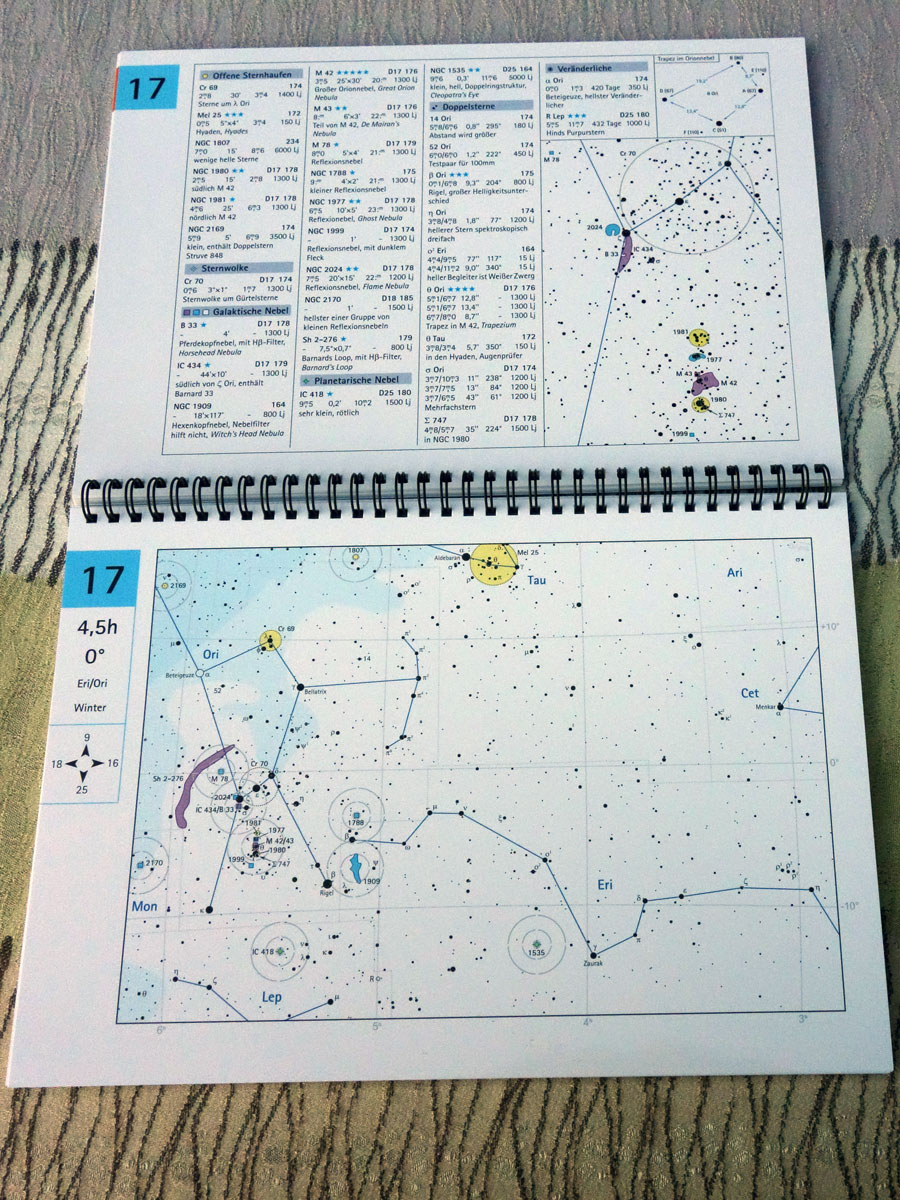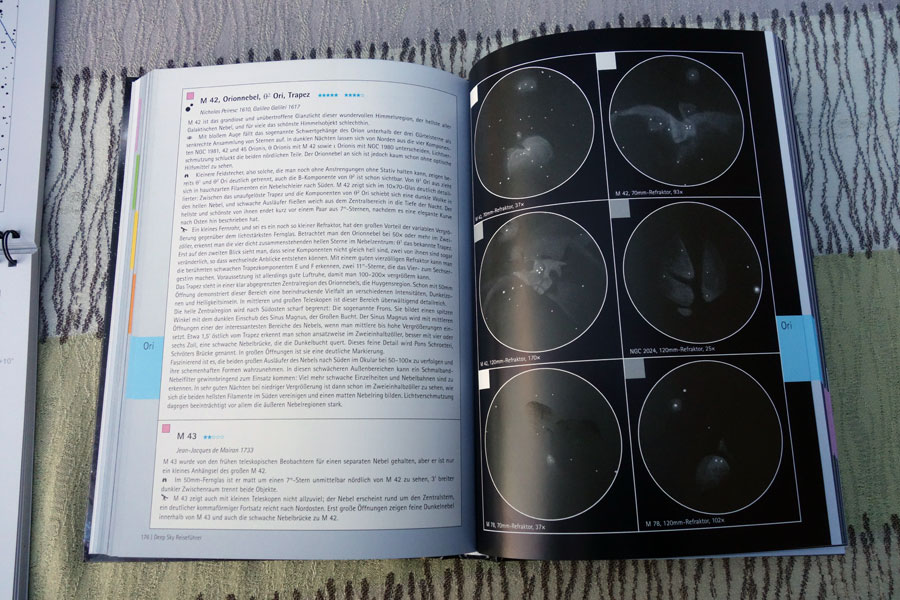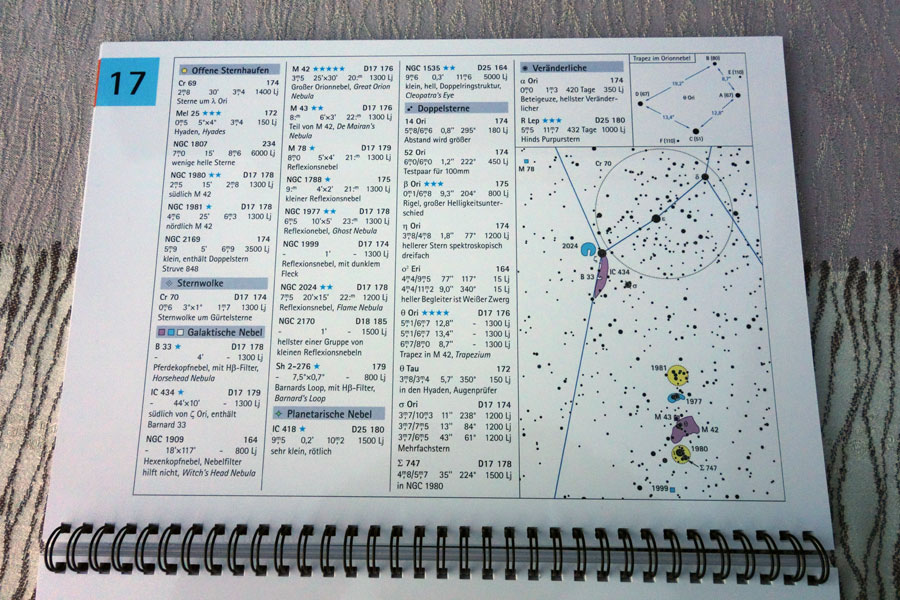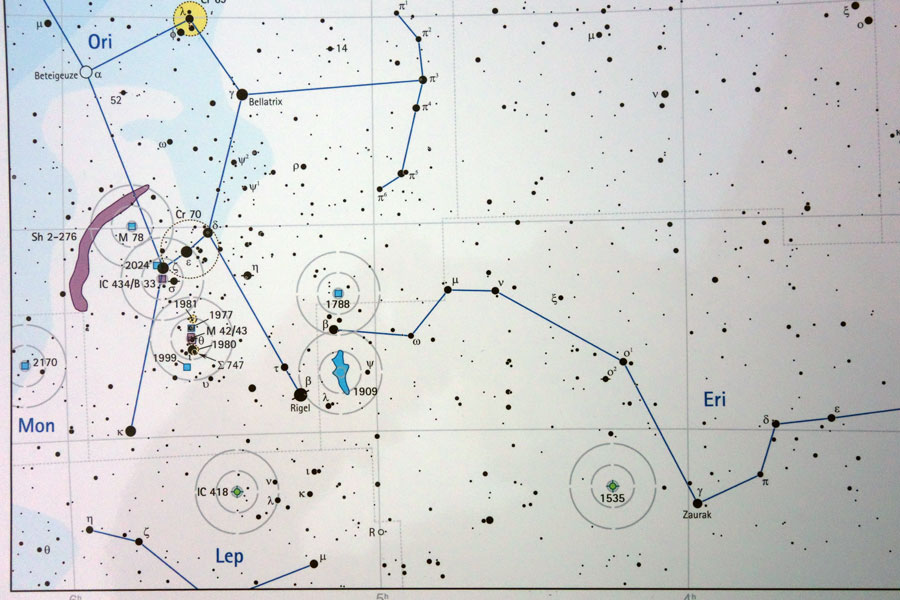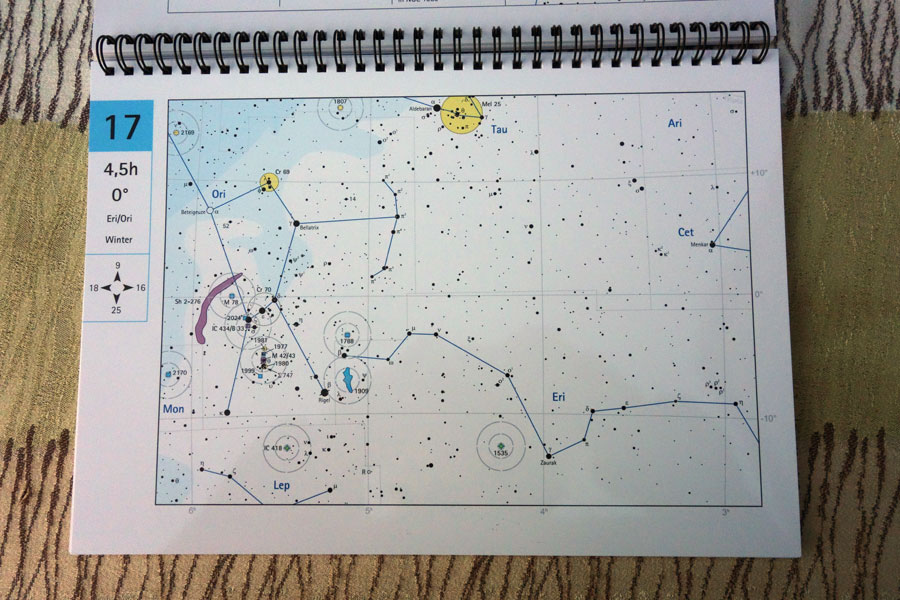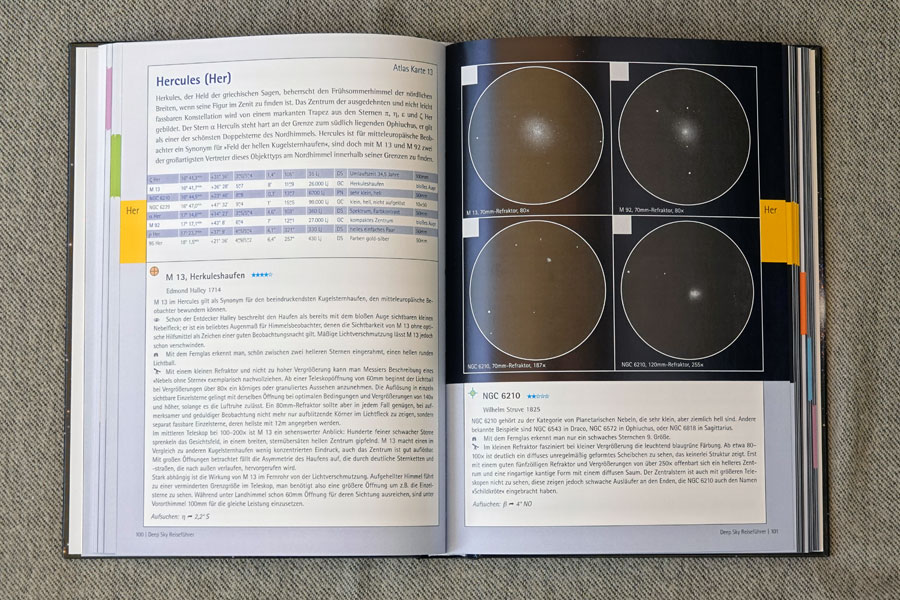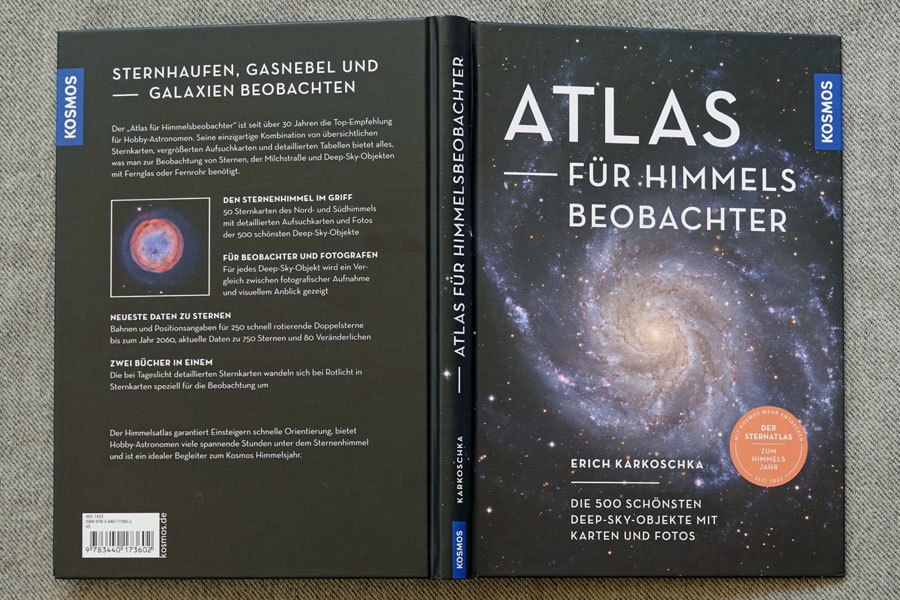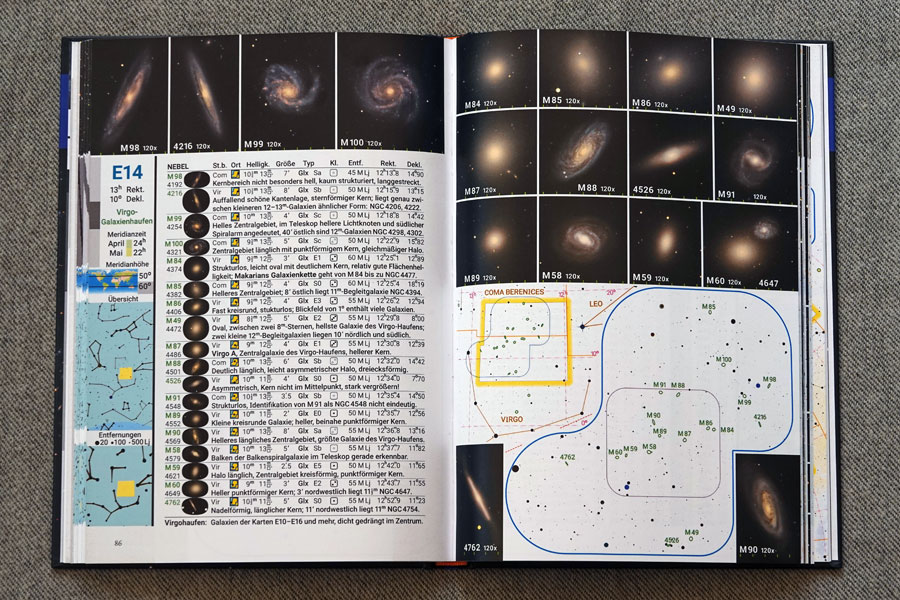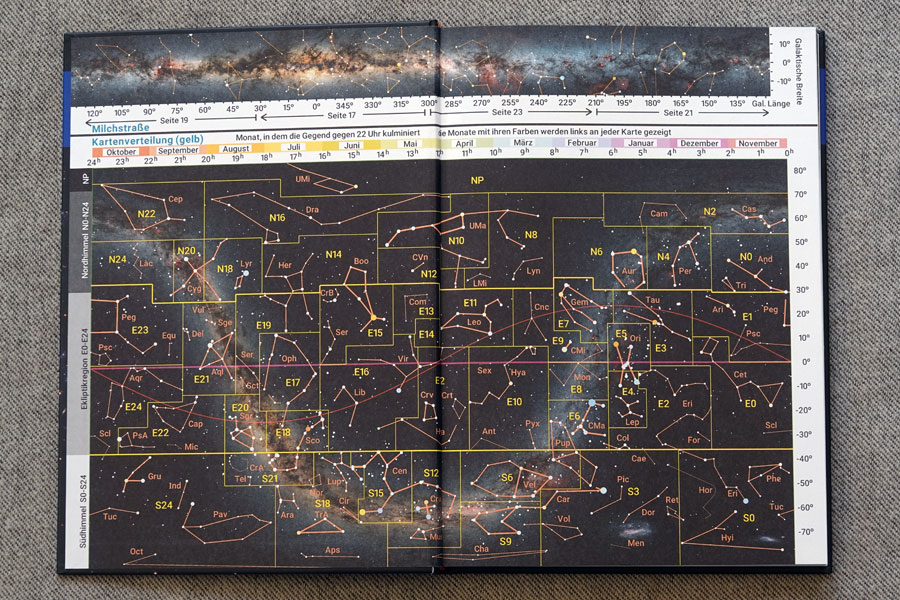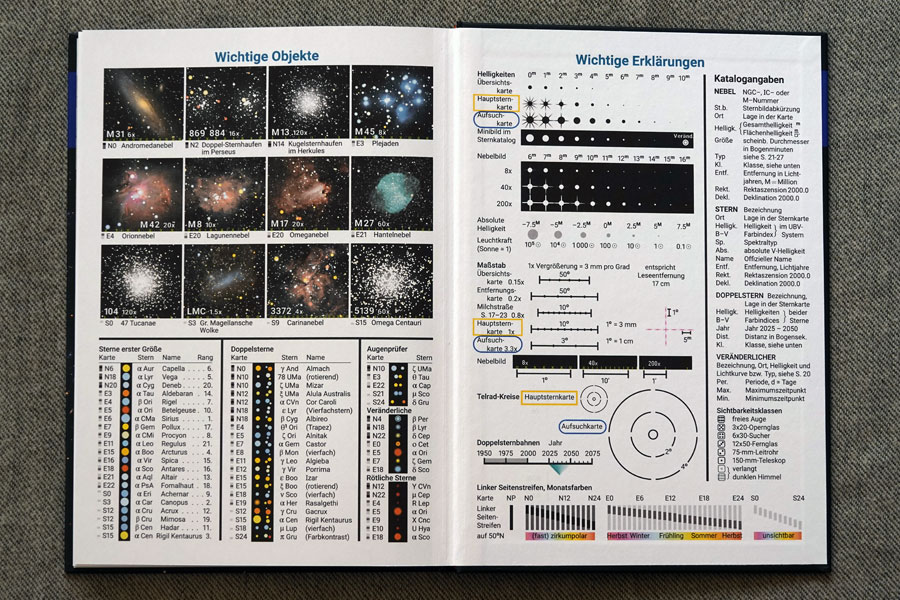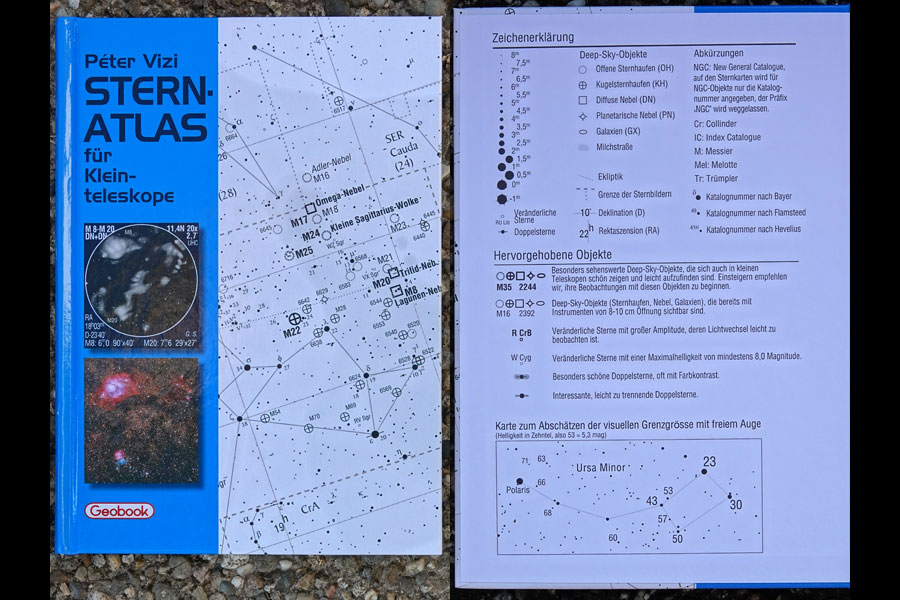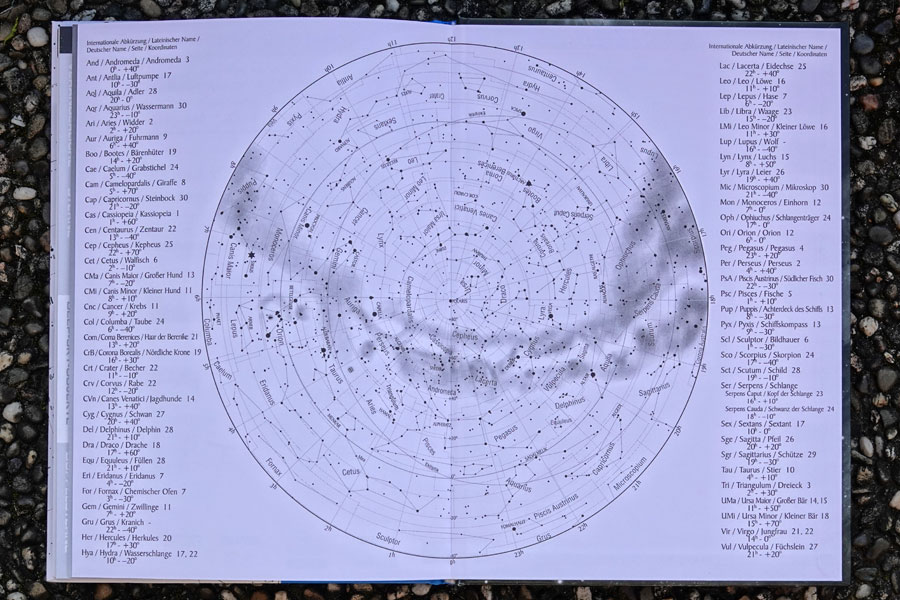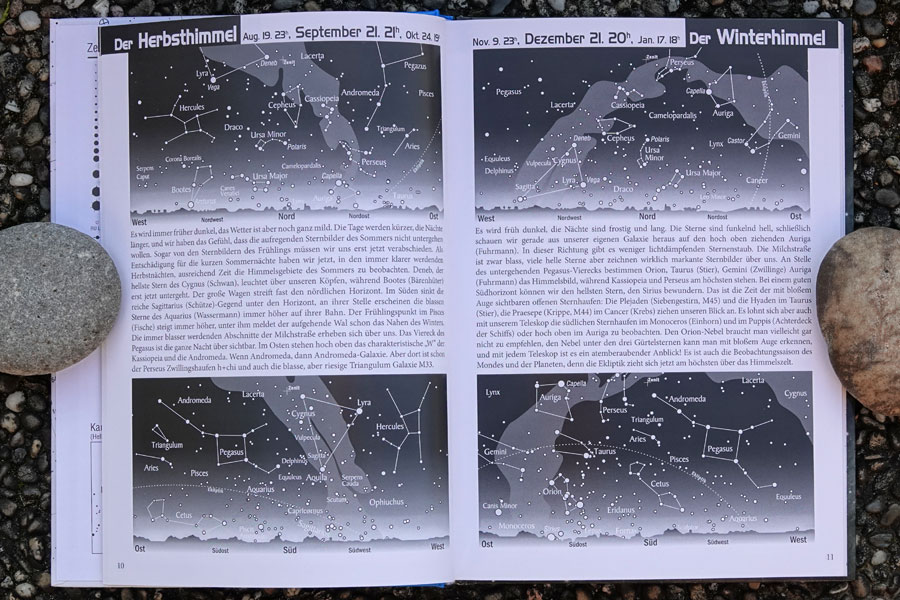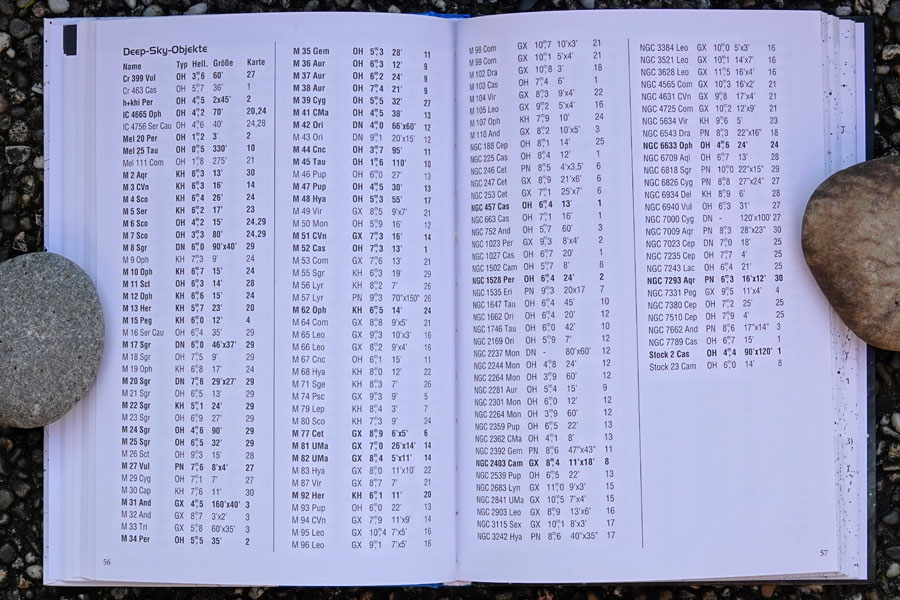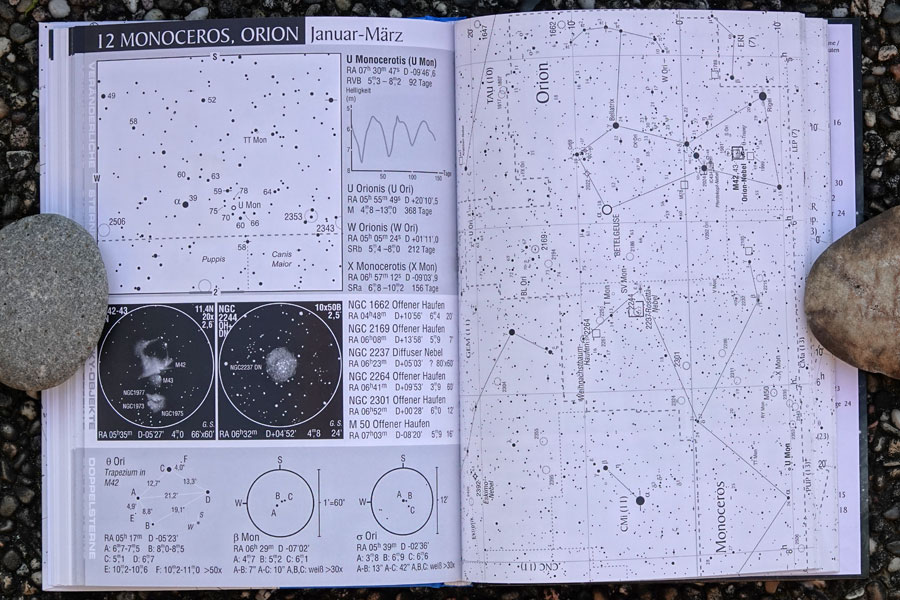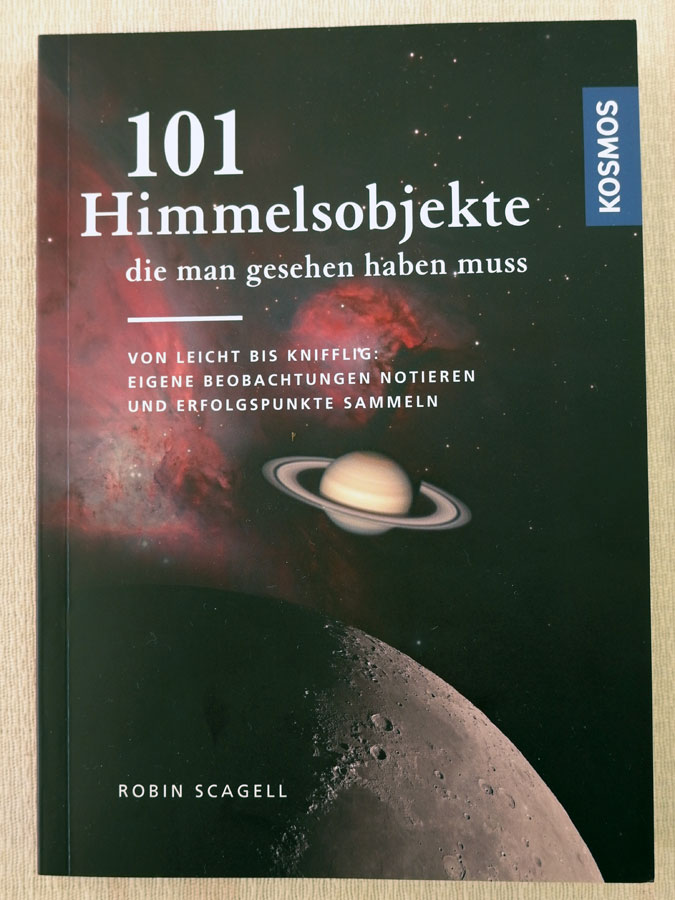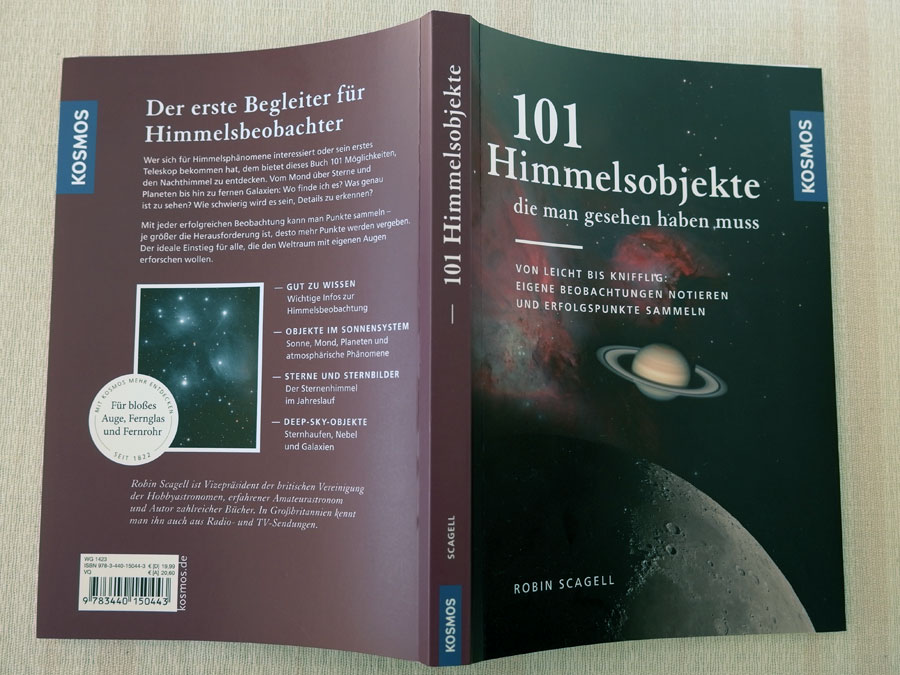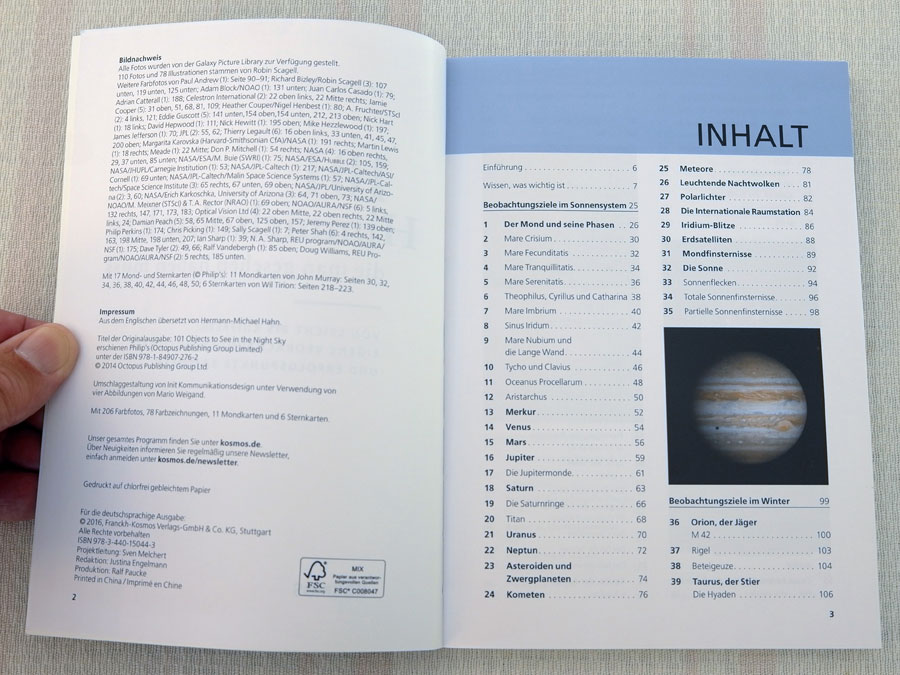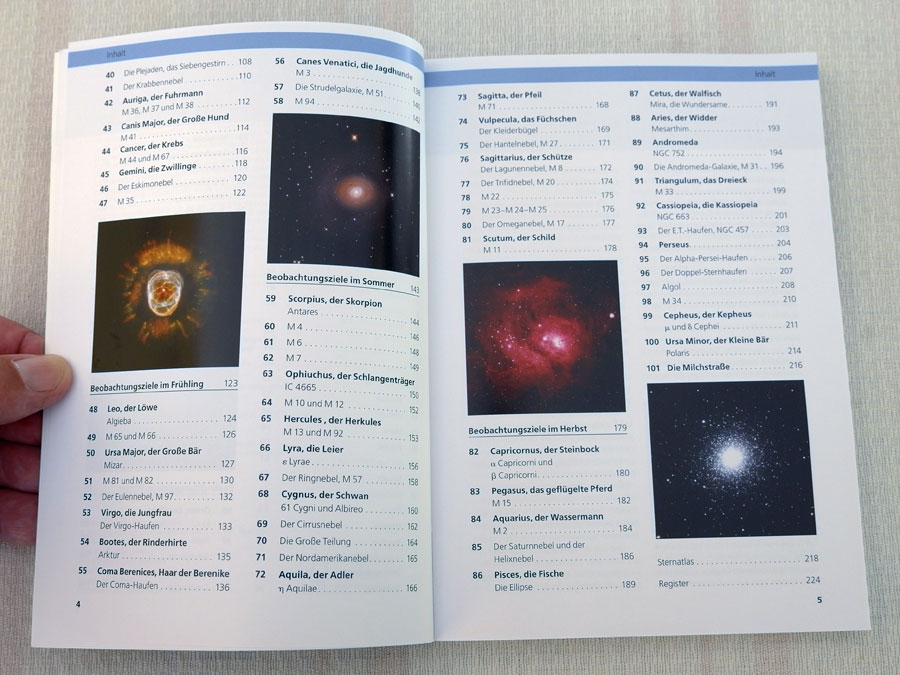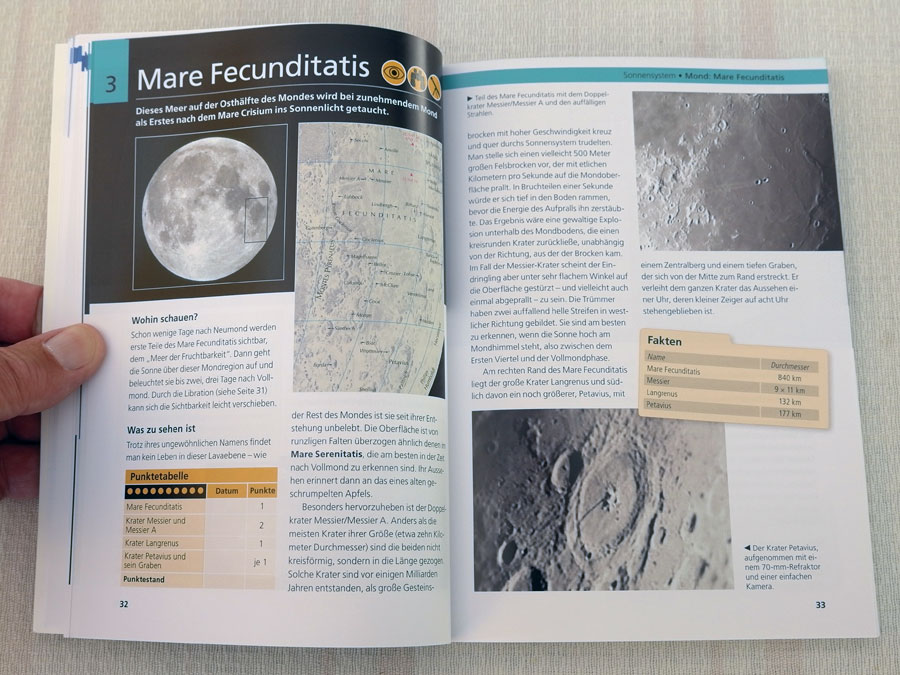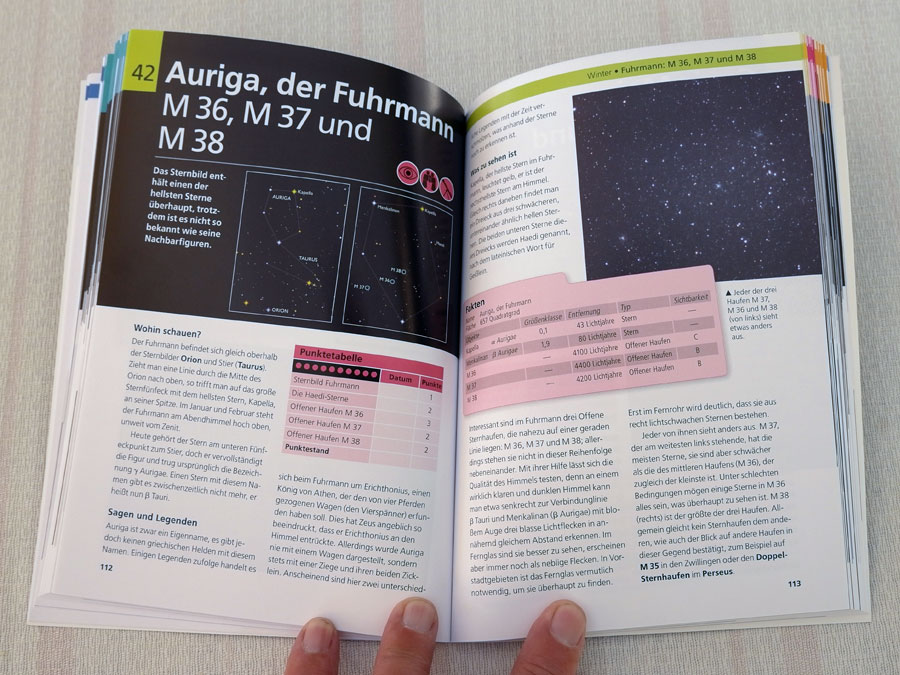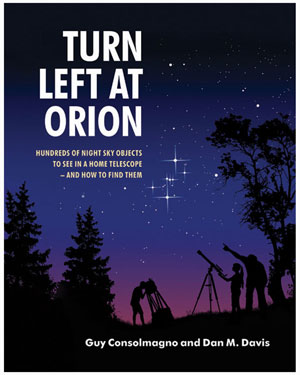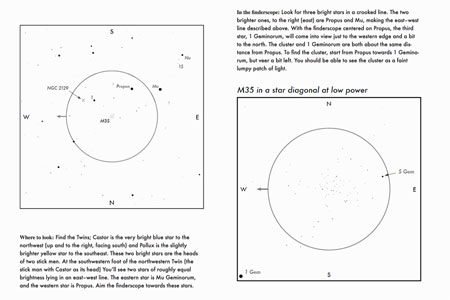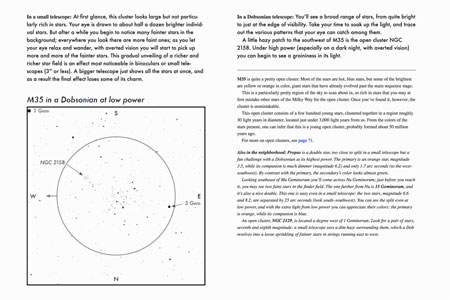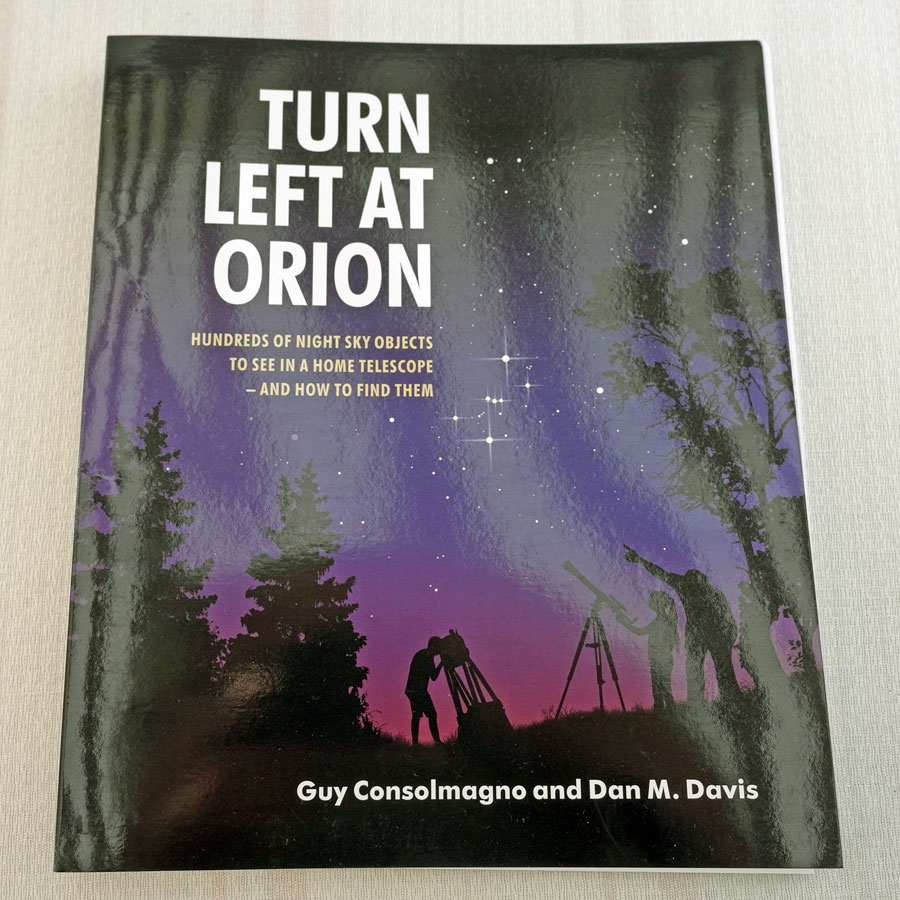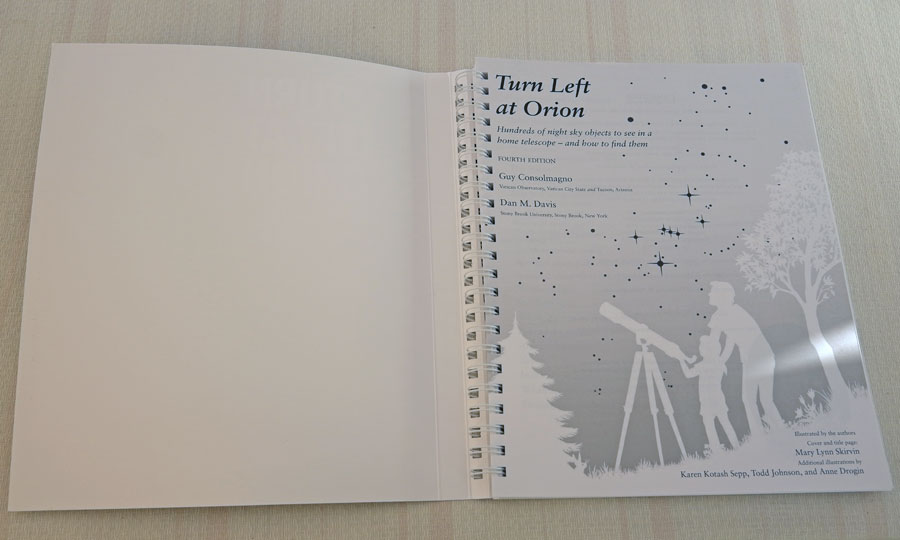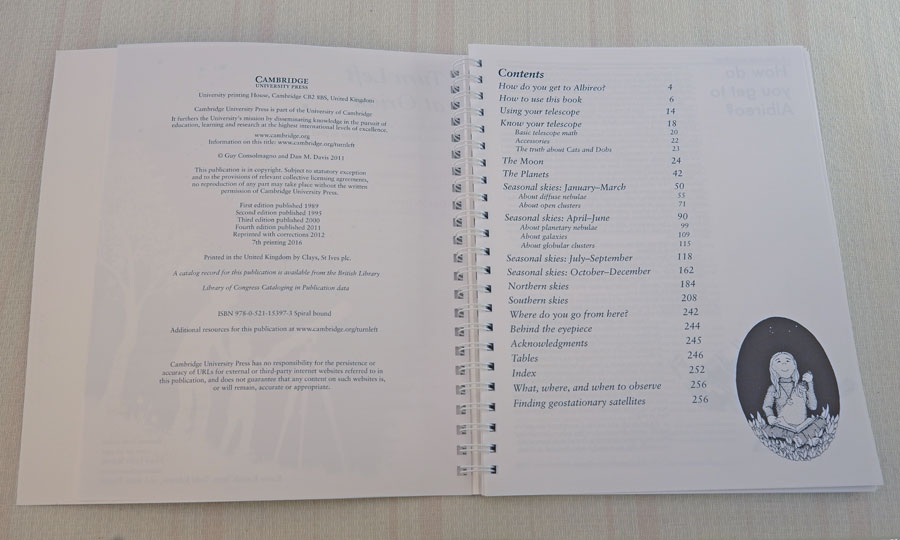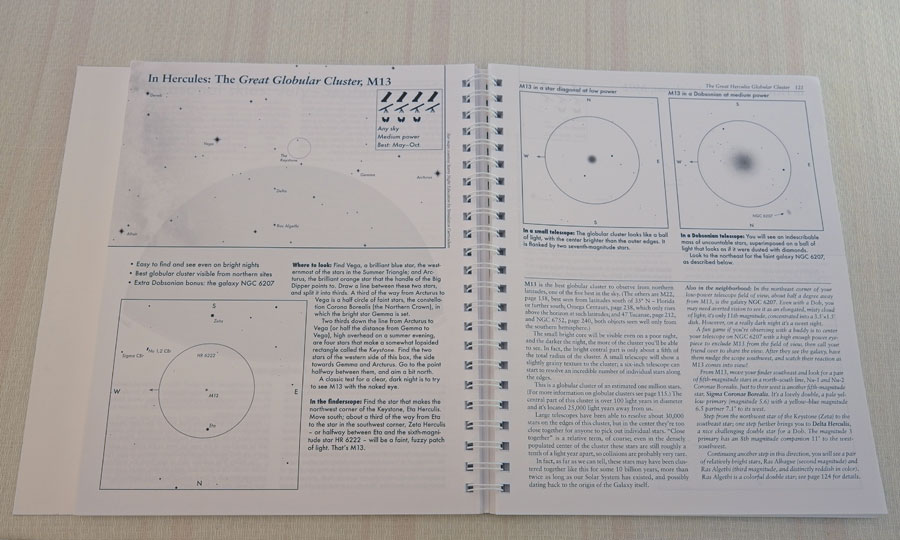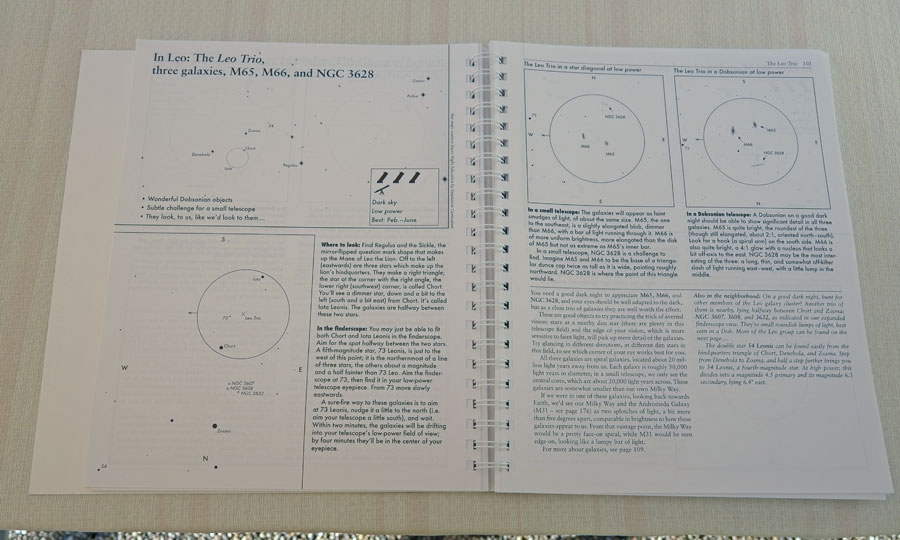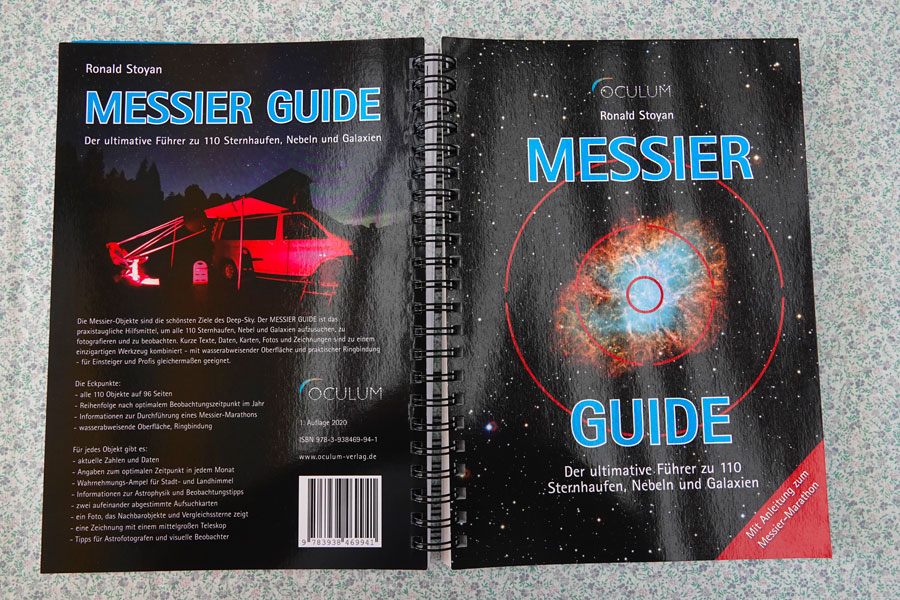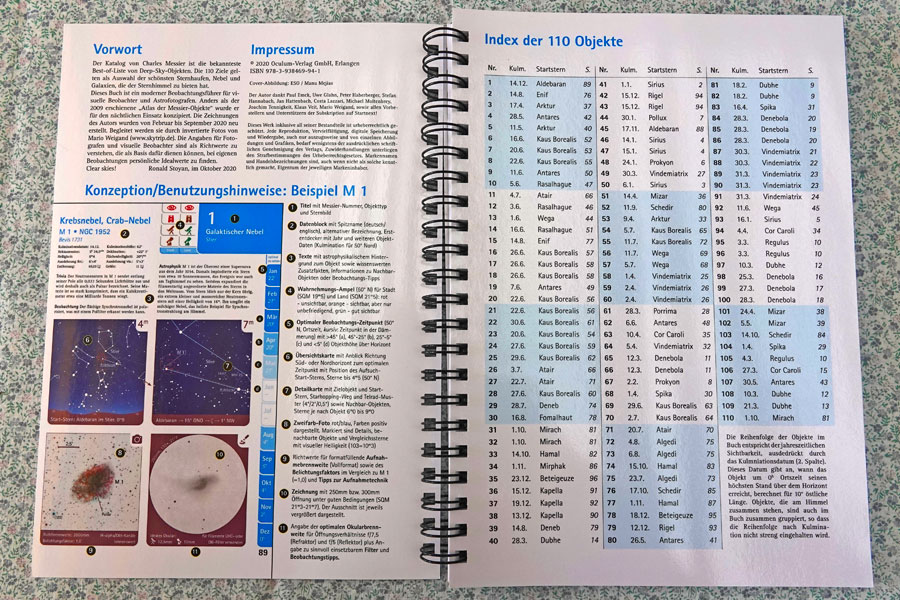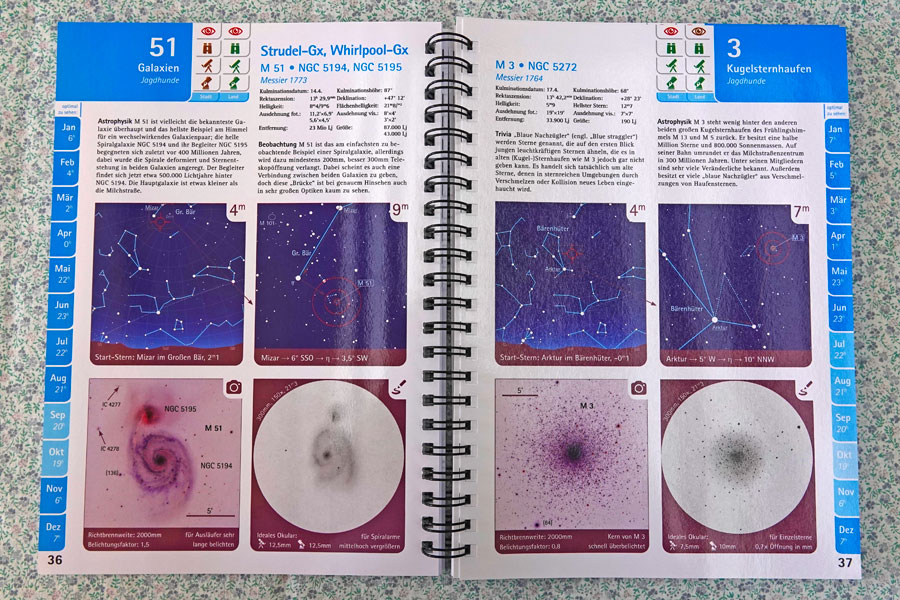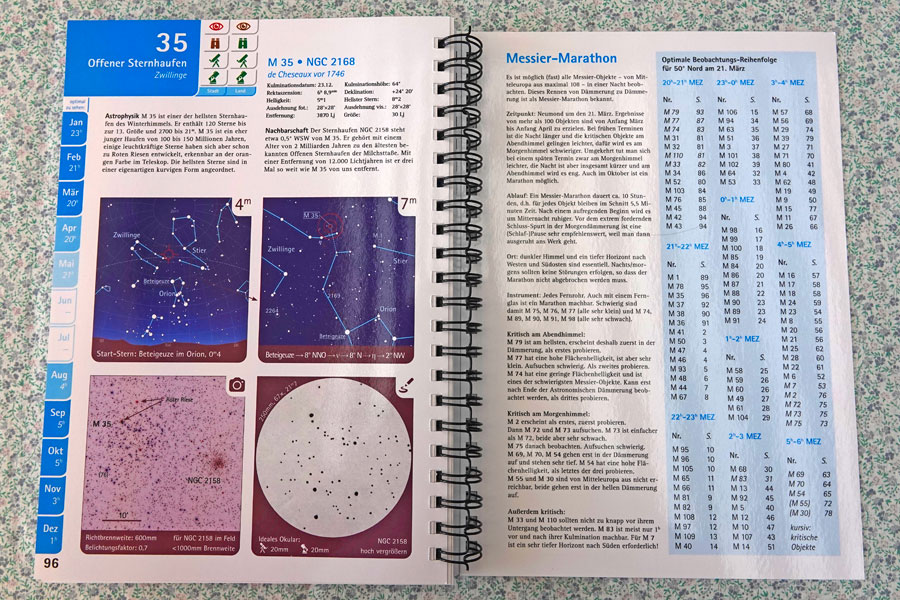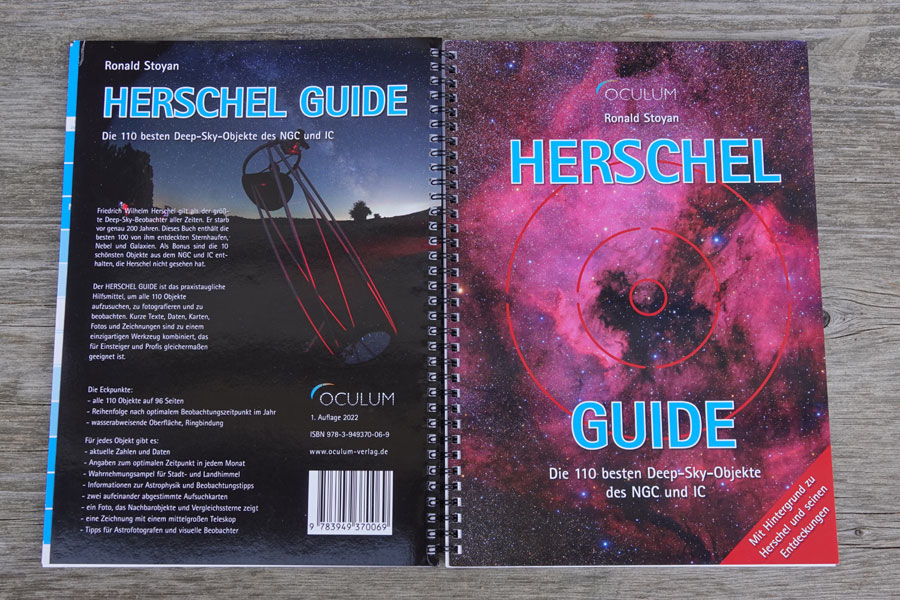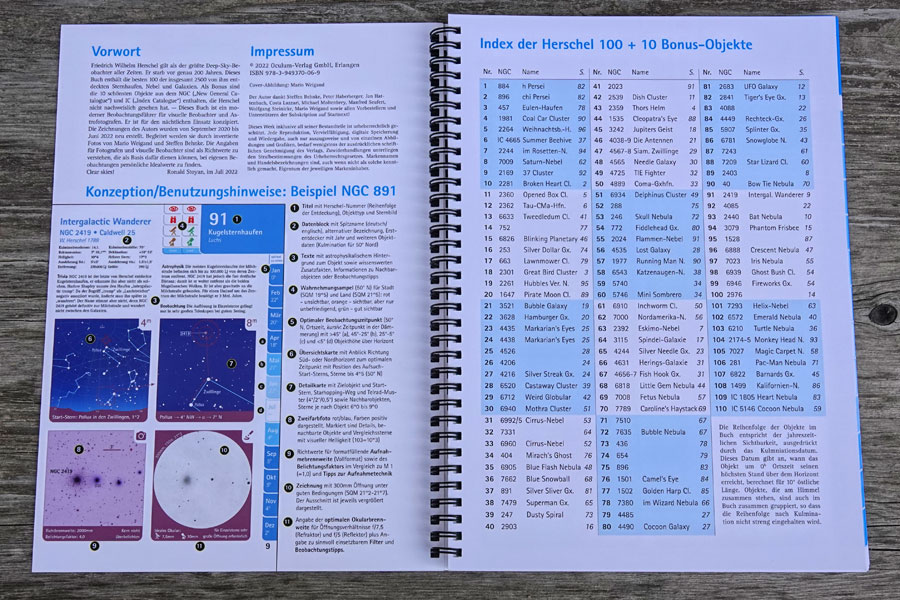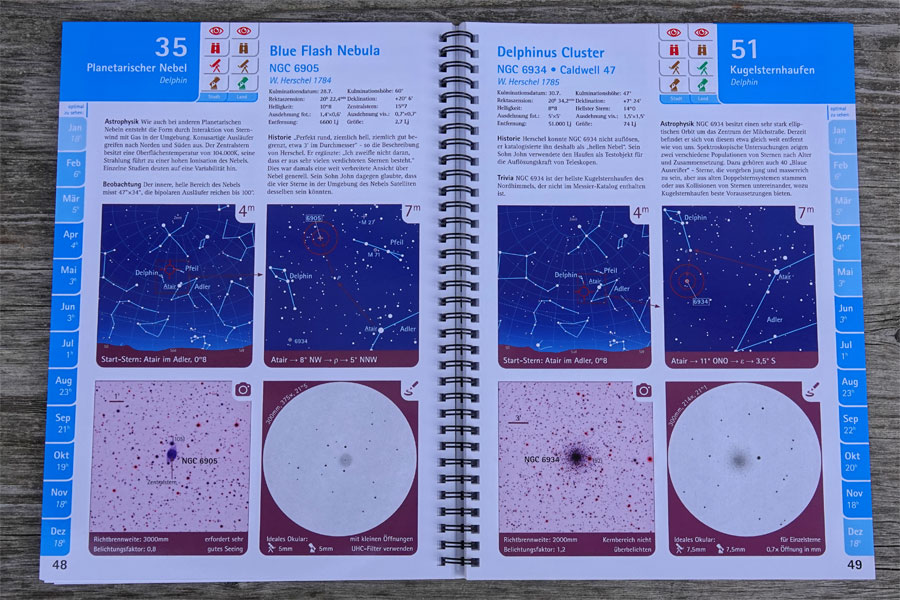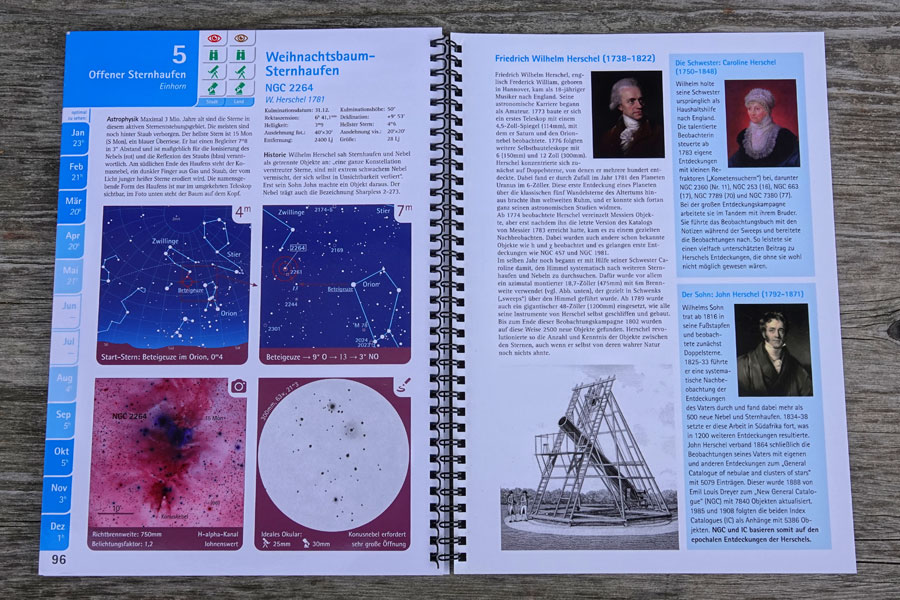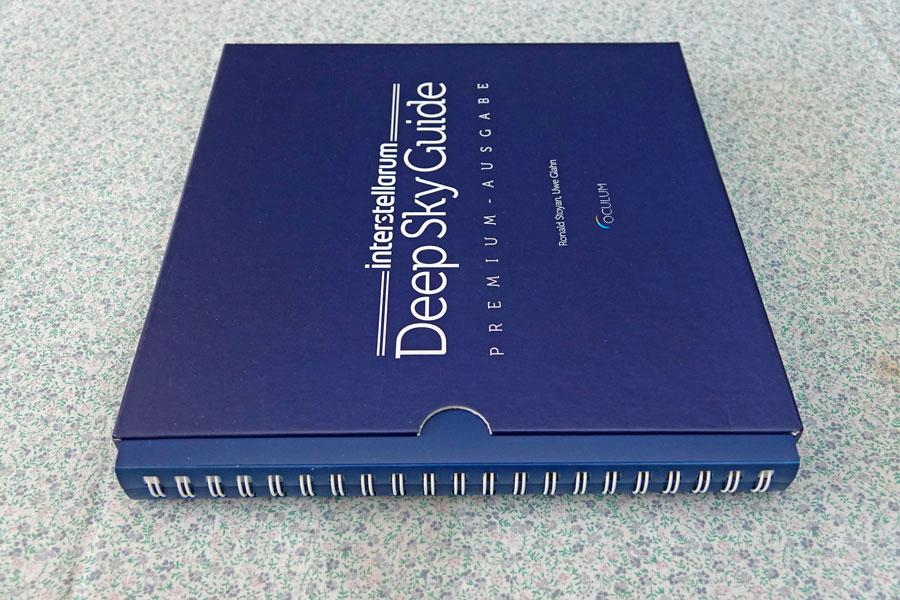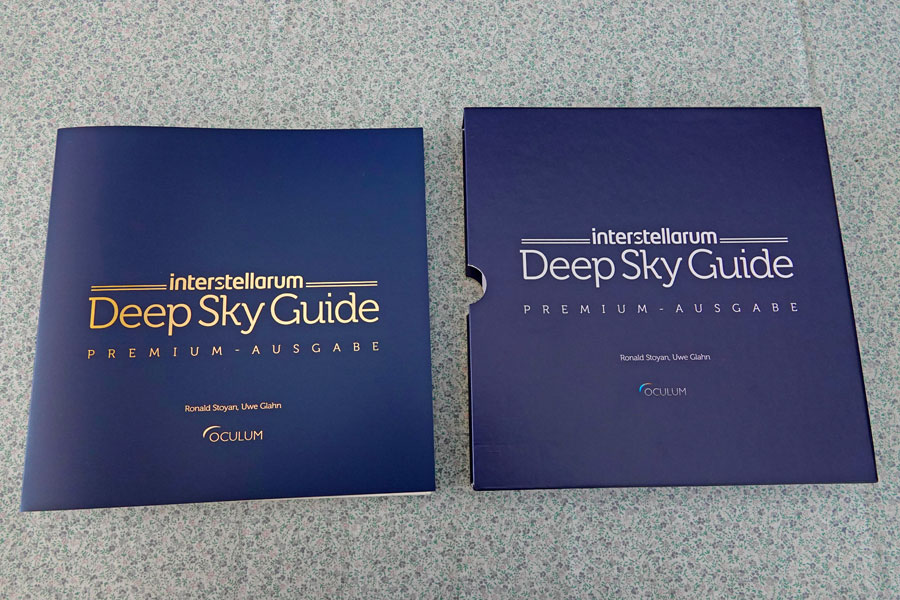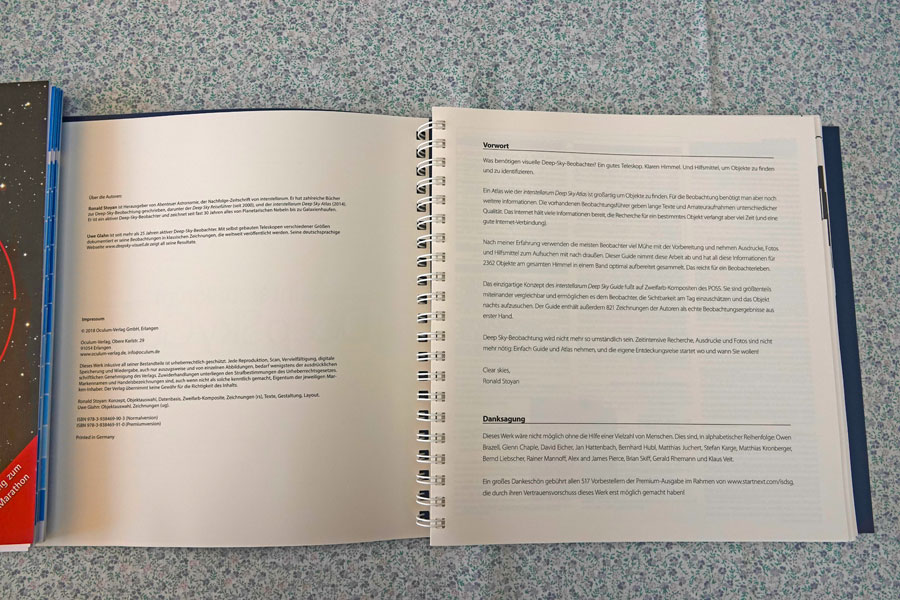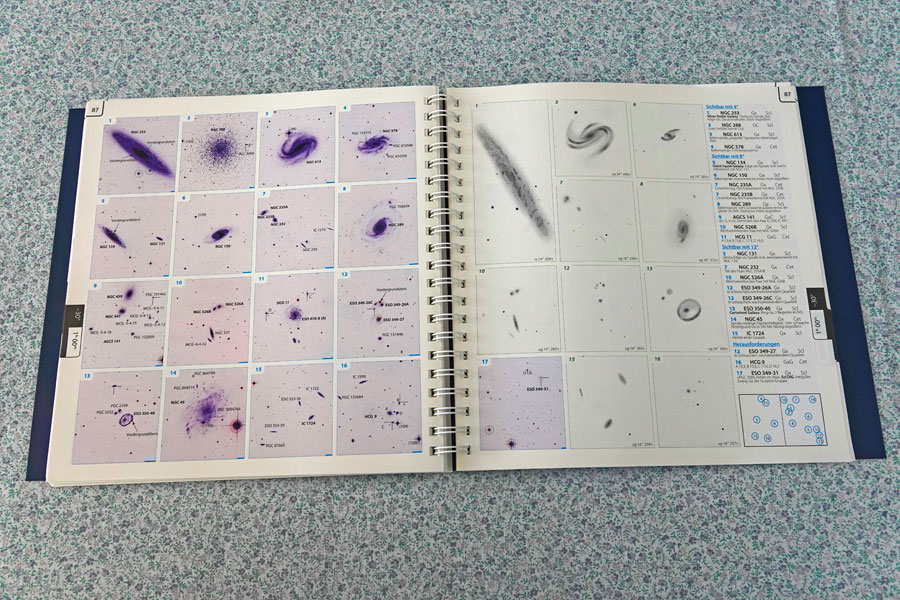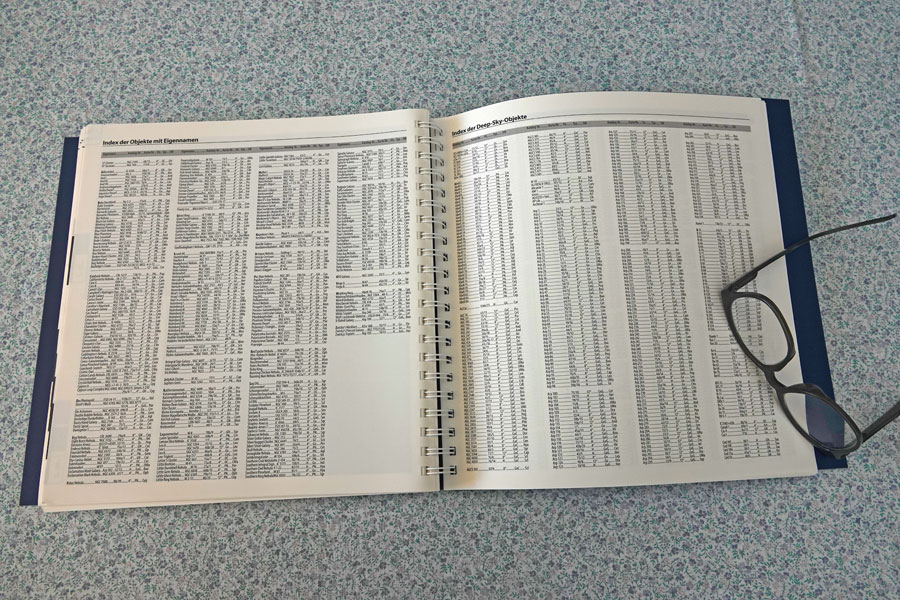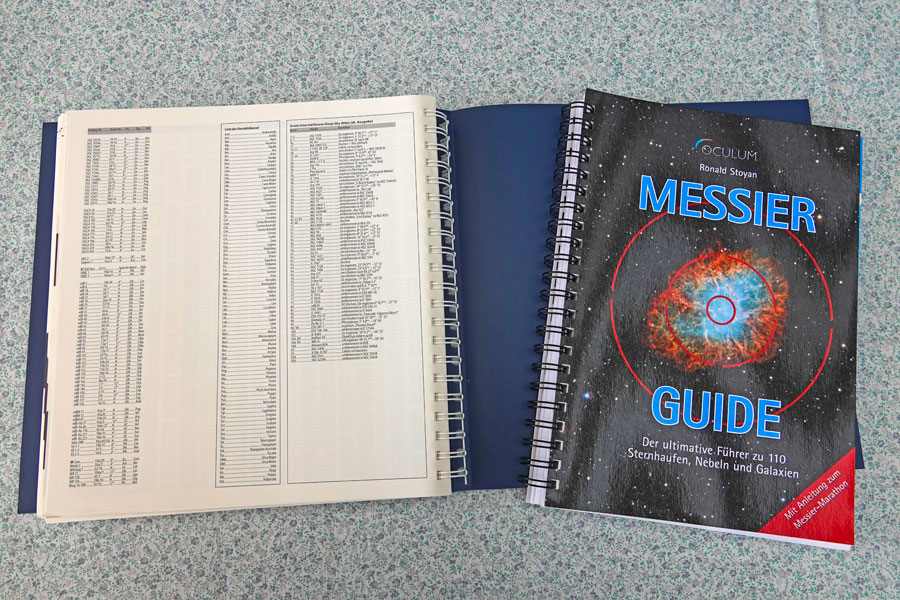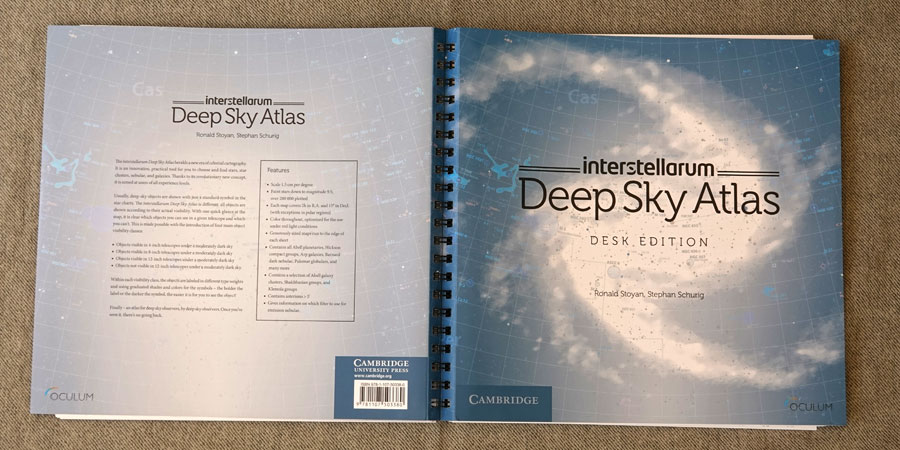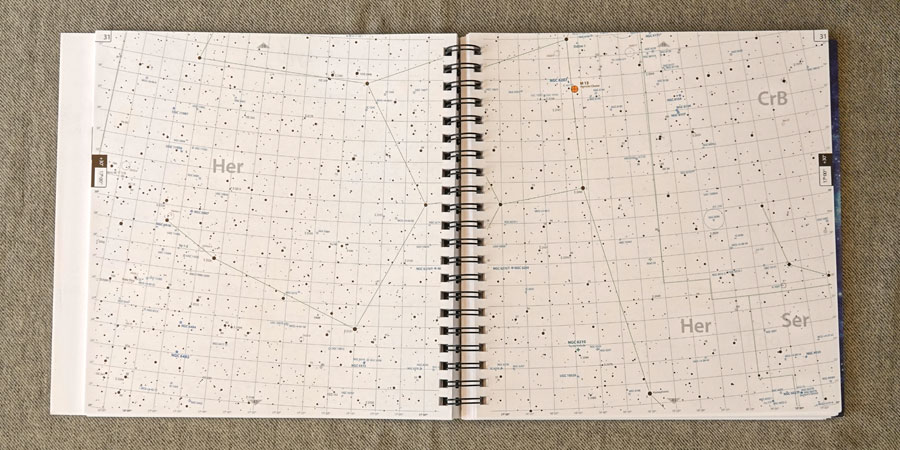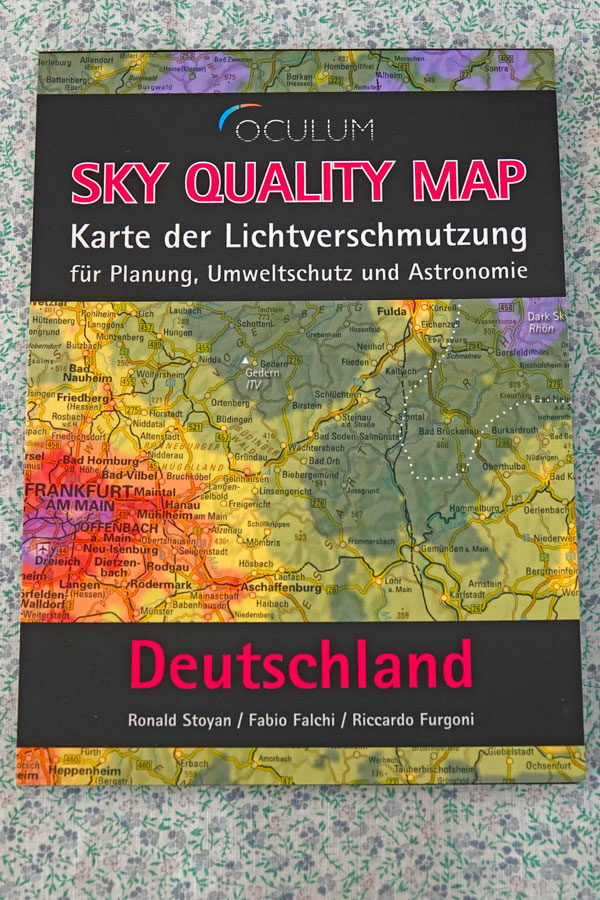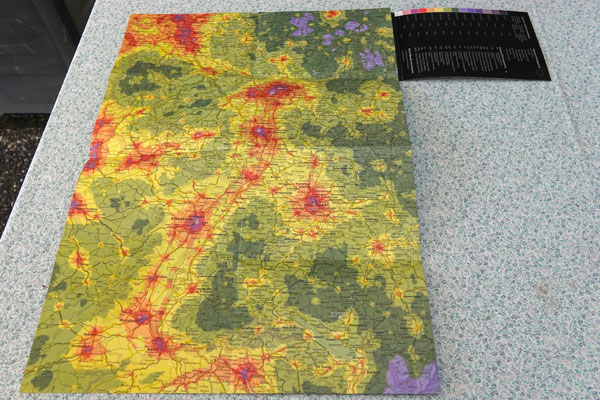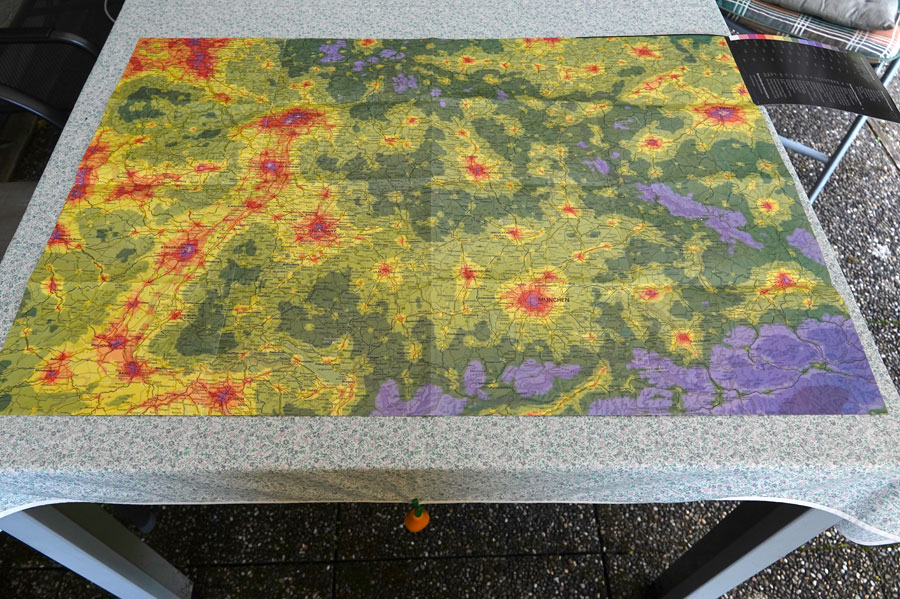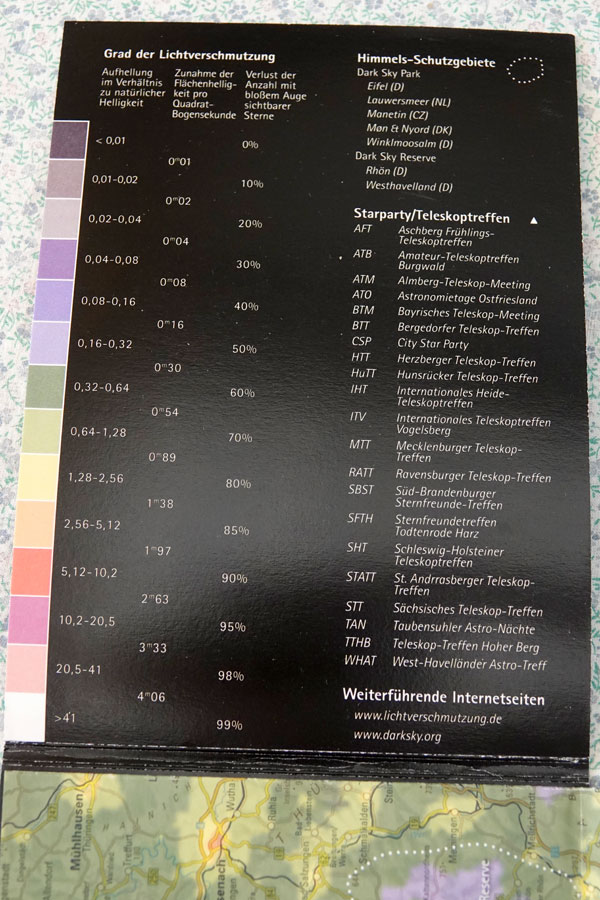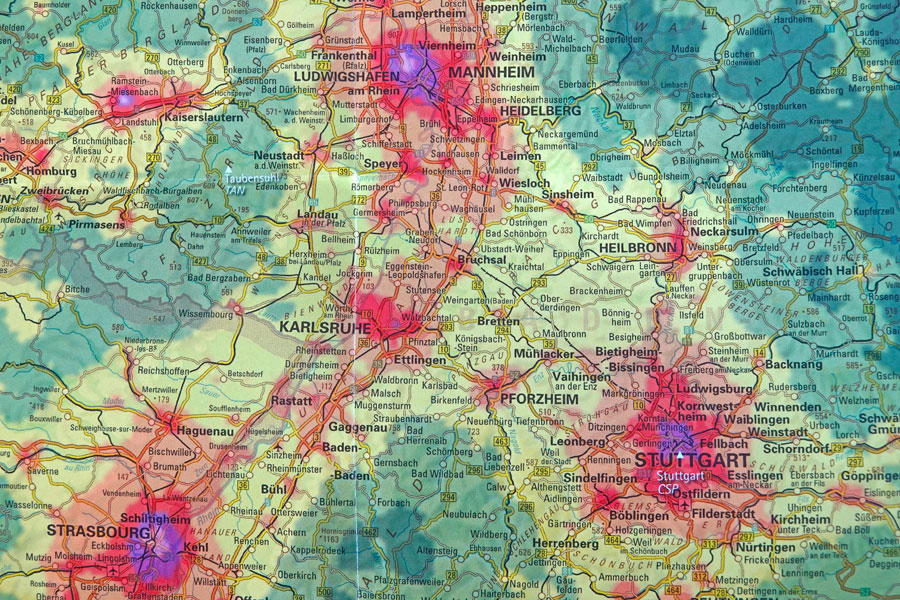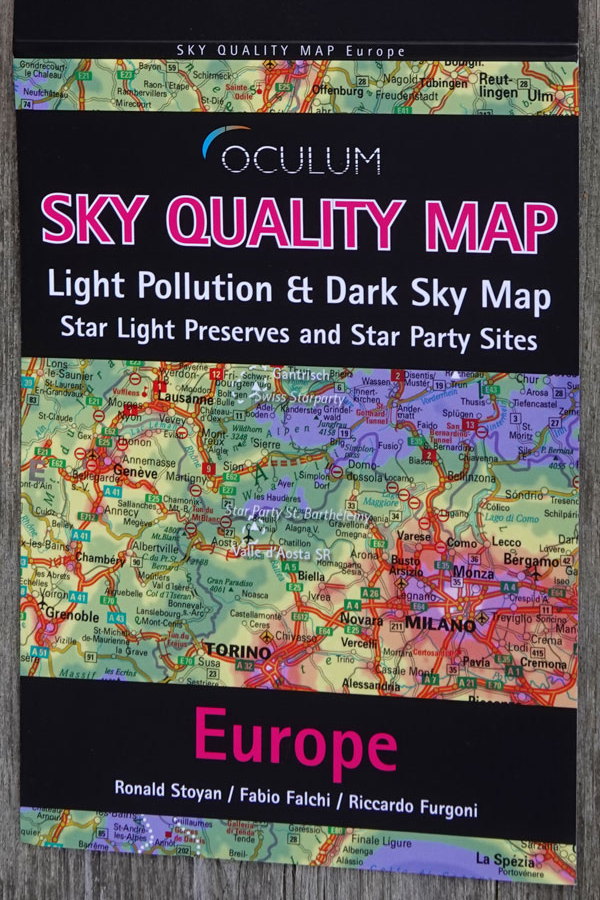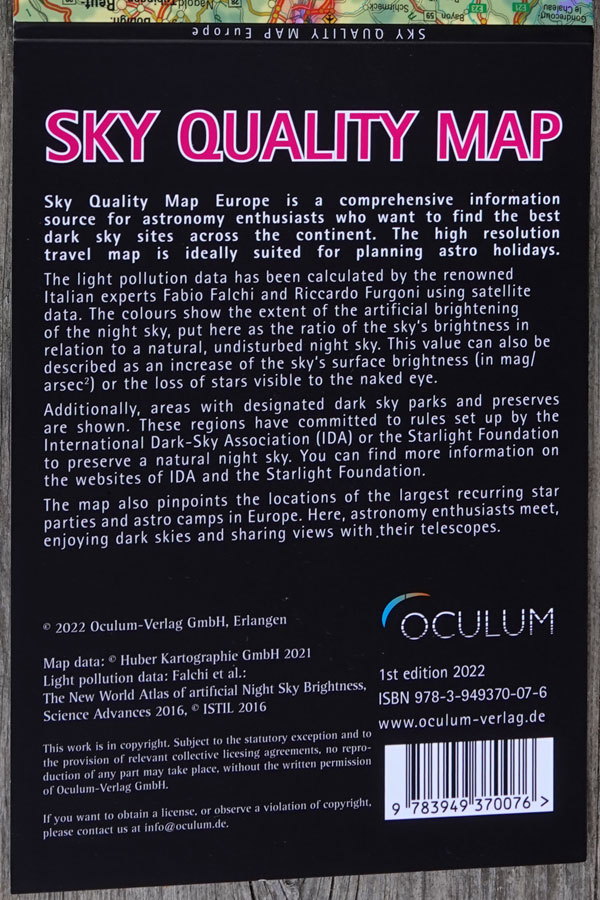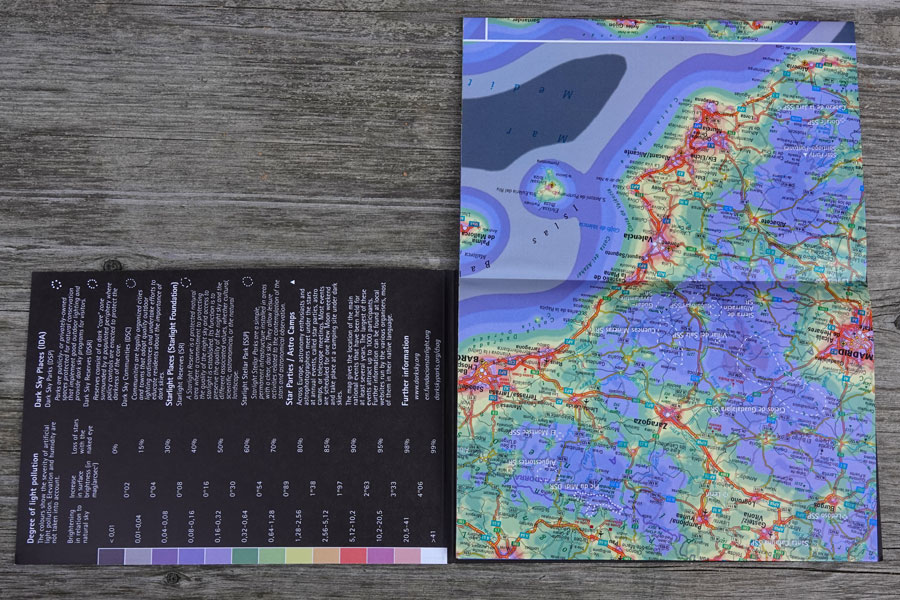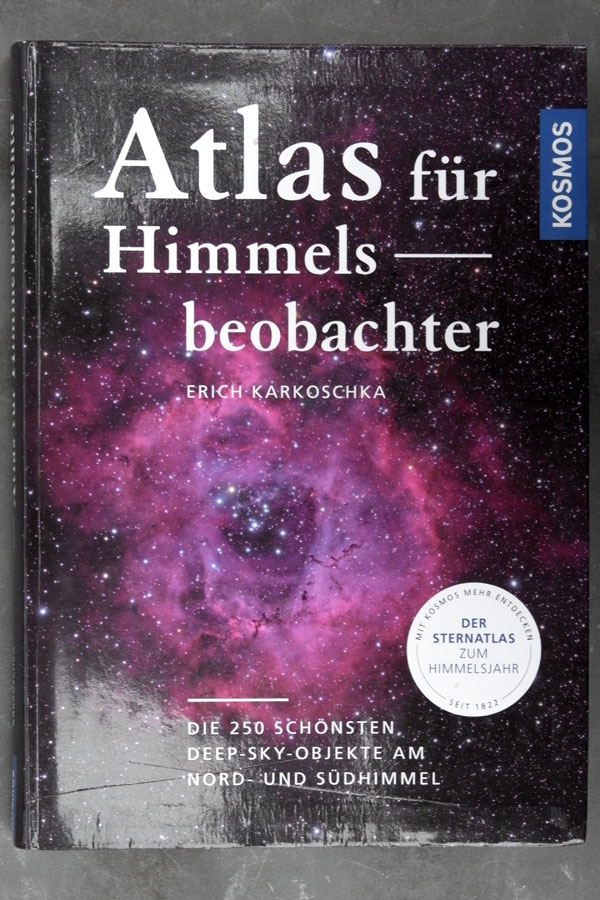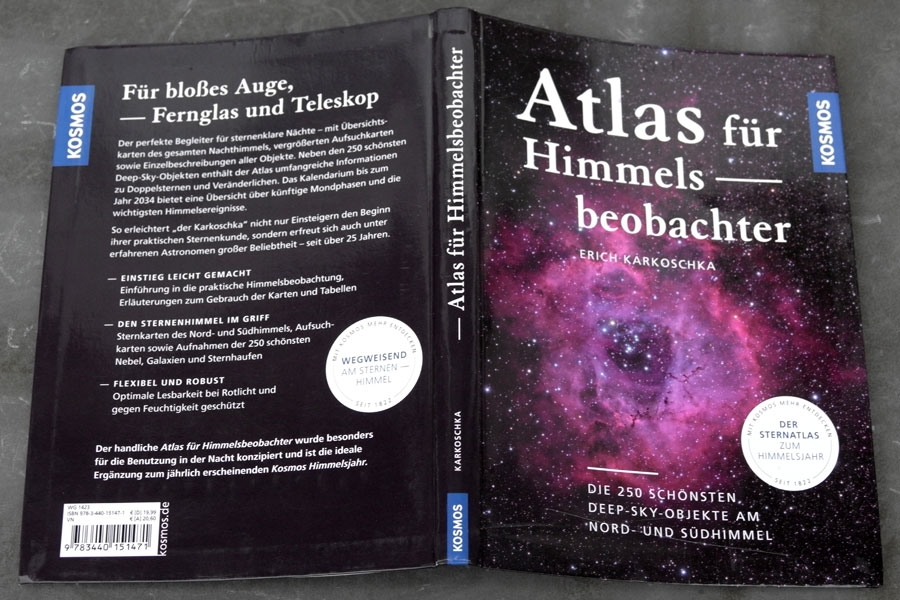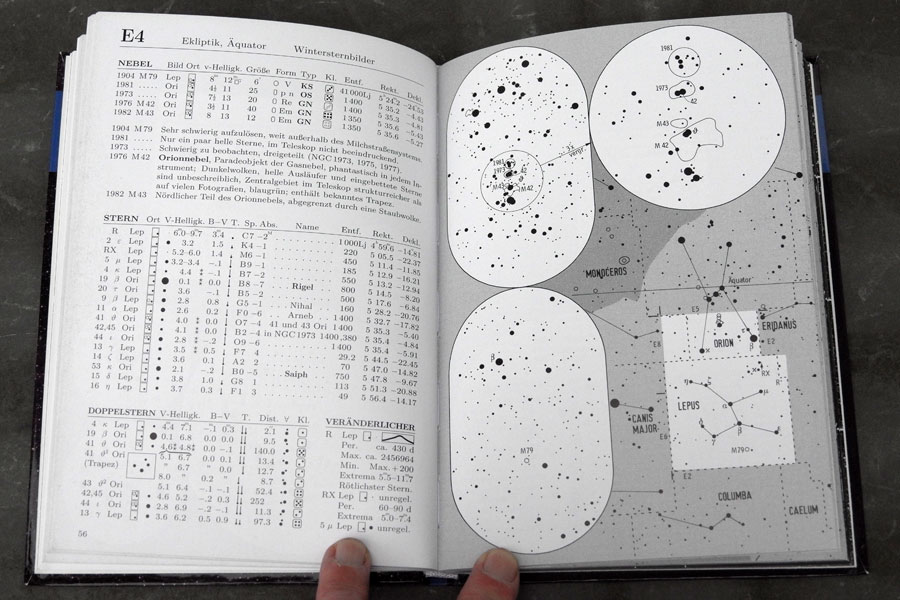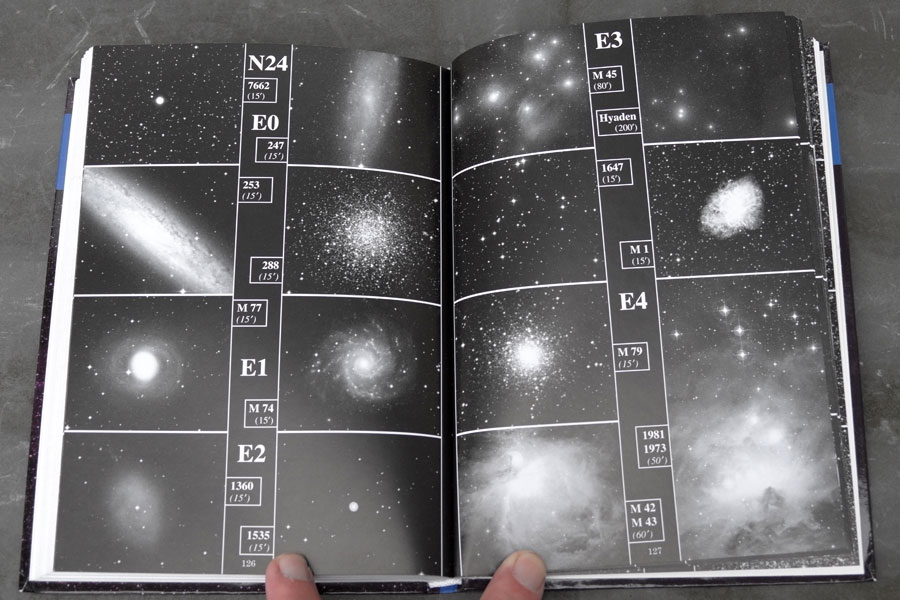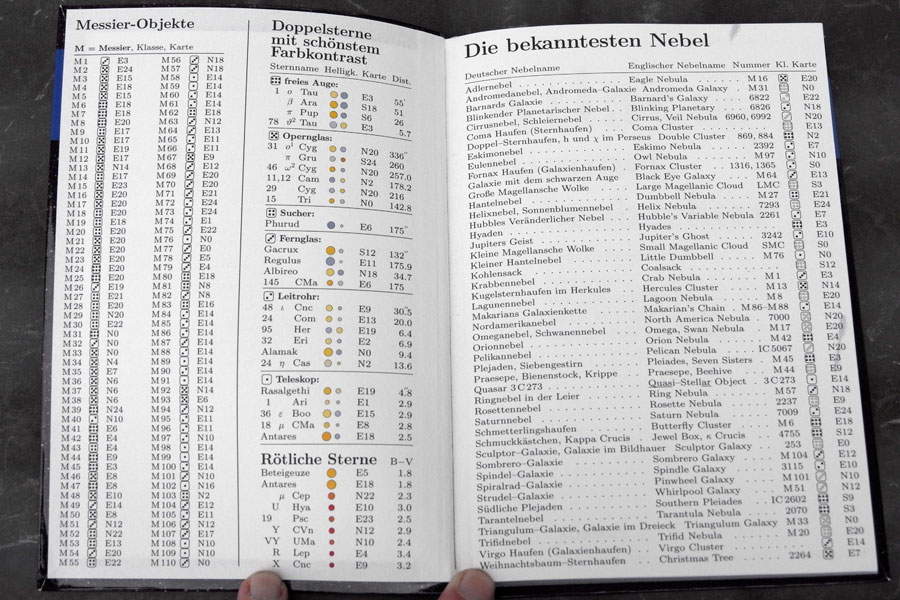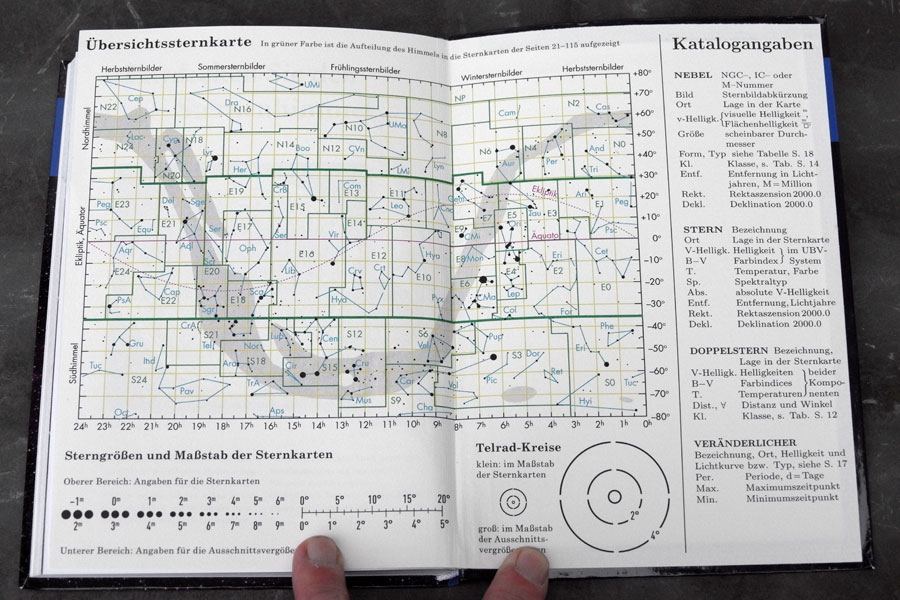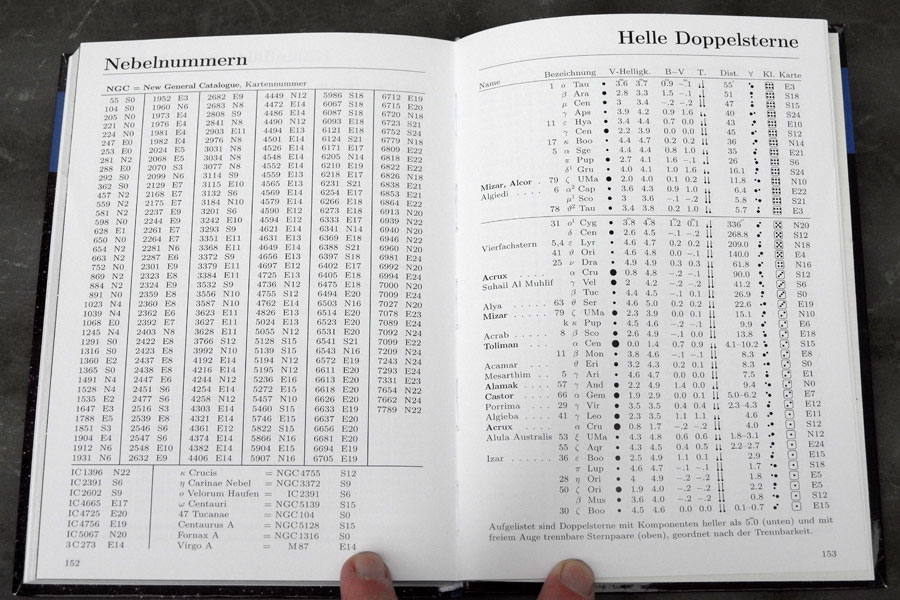Deep Sky Books
Deep Sky Reiseatlas and Deep Sky Reiseführer | Atlas für Himmelsbeobachter | Sternatlas für Kleinteleskope | 101 Objects to See in the Night Sky (101 Himmelsobjekte, die man gesehen haben muss) | Turn Left at Orion | Messier Guide | Herschel Guide | Deep Sky Guide and Deep Sky Atlas | Sky Quality Map Deutschland | Sky Quality Map Europe | Links || Appendix
On this page, I present a few books about the topic of "deep sky objects" in more detail. I bought all of these books myself, one of them also as an online version. Most of my books are in German.
Note: If you get into EAA and the world of "smart telescopes" as I did, most books lose some of their value for you because far too few objects are described in them. So you are "thrown back" to the internet (Wikipedia) and planetarium software. However, I still find the book Atlas für Himmelsbeobachter (2022) by Erich Karkoschka from the Kosmos publishers useful, especially as it presents photos of the DSO that are very similar to those that you take yourself with "smart telescopes". So you know better what to expect...
Note: See also the pages
Notes:
- I removed the link list for all books because they were redundant.
- Publishers often change the links to their books, which I often do not even notice. If links are broken, please search for the books using a search engine.
Deep Sky Reiseatlas (Maps) and Deep Sky Reiseführer (Guide)
Note: This description was taken from page Telrad
finder, but in the meantime changed. It refers to the 5th edition of the book.
Note: The Deep Sky Reiseführer was updated to a 6th edition in 2021. The look has changed only in details (most of the photos show the 5th edition).
The Deep Sky Reiseatlas (sky map for deep sky objects, in German) is designed for use with the Deep Sky Reiseführer, which describes selected objects in more detail (in German) and shows them as drawings (310 drawings by the author). In the Reiseatlas you will find the corresponding page numbers of the Reiseführer next to the objects. The Deep Sky Reiseatlas is also adapted to the use of the Telrad finder and shows what the view through the Telrad finder would look like for selected deep sky objects.
Drawings have the advantage over photos, which were typically taken with long exposure times and show a lot of objects, that they resemble the view through the telescope - provided you have a telescope similar to the one used for the drawing. Some objects are also shown for different telescopes and at different magnifications, and the differences are often considerable.
By the way, I find the about 40 introductory pages in the Deep Sky Reiseführer very useful.
Note: The descriptions and drawings of the objects are only useful for visual observations!
|
Cover of the Deep Sky Reiseführer (guide) |
Deep Sky Reiseatlas: Double pages present descriptions and a map of a certain section of the sky |
|
Deep Sky Reiseführer: Description of the Great Orion Nebula M 42 (the page number is given in the Reiseatlas), plus paintings of how the object looks in smaller telescops and under different viewing conditions |
Deep Sky Reiseatlas: The upper pages present descriptions of important sky objects and sometimes detail maps |
|
Cover of the Deep Sky Reiseführer, 6th edition |
Sample page of the Deep Sky Reiseführer, 6th edition |
- Michael Feiler & Philip Novak (2023). Deep Sky Reiseatlas (5th edition), Oculum Verlag (ISBN 978-3-949370-04-5)
www.oculum-verlag.de/detailview?no=608 (in German) - Michael Feiler & Philip Novak (2014). Deep Sky Reiseatlas, Oculum
Verlag
(ISBN: 978-3-938469-71-2)
www.oculum-verlag.de/detailview?no=2014 (in German) - Ronald Stoyan (2021). Deep Sky Reiseführer (6th edition), Oculum Verlag (ISBN: 978-3-938649-72-9)
www.oculum-verlag.de/detailview?no=603 (in German) - (Ronald Stoyan (2014). Deep Sky Reiseführer (5th edition), Oculum Verlag (ISBN: 978-3-938649-72-9)
www.oculum-verlag.de/detailview?no=2015) (in German)
Atlas für Himmelsbeobachter
The Atlas für Himmelsbeobachter (atlas für sky watchers) by Erich Karkoschka is in a way a "mini version" of the Deep Sky Atlas/Reiseführer combination. It presents considerably fewer deep sky objects, but this can be an advantage for beginners. For me, both solutions complement each other well and I usually consult both of them whenever I want to observe deep sky objects. By the way, in this guide, the deep sky objects are shown as photos (not taken by the author), which can be useful as well at times.
Admittedly, I prefer the maps in the Deep Sky Reiseatlas to those in the Atlas für Himmelsbeobachter, I find these maps clearer. However, if I want to take only one book with me or out (for example, when traveling), the "Karkoschka" is my first choice.
Notes: The Atlas für Himmelsbeobachter (atlas für sky watchers) was updated in 2022. The look has changed dramatically, the content only marginally. I like the new edition much more, because DSO photos (now in color) are shown on the page on which the DSO are descibed. I find the book still useful for EAA and smart telescopes, especially as it presents photos of the DSO that are very similar to those that you take yourself with "smart telescopes". So you know better what to expect...
|
Inner pages at the front |
Inner pages at the back |
- Erich Karkoschka (2022). Atlas für Himmelsbeobachter, Kosmos Verlag (EAN: 9783440173602)
www.kosmos.de/de/atlas-fur-himmelsbeobachter_1074889_9783440173602 (in German)
Sternatlas für Kleinteleskope (Sternatlas für den visuellen Beobachter)
In the beginners' corner of Sven Wienstein's Webseite, I found a review of the book Sternatlas für den visuellen Beobachter (star atlas for the visual observer) by Péter Vizi, in which this book was presented as an alternative to the Karkoschka book (ISBN 0789638783523, Verlag Geobook, Ungarn). Wienstein reviews the first and the third (2011) edition of the books, which however, seem to be unavailable. Finally, I found the similarly looking book Sternatlas für Kleinteleskope (star atlas for small telescopes) by Péter Vizi on the Teleskop-Express Website, a dealer's Website, and ordered it (it differs there, besides having another ISBN 9786155015052, in the title and in the blue instead of yellow cover color - I was not able to find out more).
When the book arrived, I looked at the imprint, which showed that it was the first edition from 2011. A look at Wienstein's Website showed that this version is probably identical with the third edition of the book discussed by him. As my version of the book contains advertising for the dealer on the back and on the last pages, it seems to be a reprint of the original book with a changed title and maybe some other changes, which I cannot find out, of course.
All in all I would like to refer interested parties to the review by Sven Wienstein, on the basis of which I purchased the book. As Wienstein writes, the book is targeted at beginners, which is OK for me. During a first run through the book I found one or the other good practical tip, but I am not so happy with the atlas section, because there are only a few DSO presented per map. In my second attempt, however, I grasped the principle better. It seems to be best to always work with the overview list (p. 56-57) of the presented DSO to see on which page a DSO is described/shown. Some DSOs appear on several maps, but all of them are only described or presented as a drawing on one map. DSOs are divided into three groups:
- The especially "worth seeing" DSO recommended for beginners (bold symbol, big bold font) -> in the overview list (bold)
- The DSO, which are already visible with an openiung of 8-10 cm (semi-bold symbol, large font) -> in the overview list
- the rest (normal symbol, small font)
The first tweo groups make up nearly 150 nebulae, galaxies ans star clusters. I have yet to find out, how and whether the book will prove itself for me in practice...
|
Introductory pages |
Seasonal sky charts |
|
List of proposed DSO |
Example page in the atlas section with drawings of DSO |
- Teleskop-Service, Sternatlas für Kleinteleskope (Autor: Péter Vizi; ISBN: 978-615-5015-05-2): www.teleskop-express.de/shop/product_info.php/info/p5068_Sternatlas---Start-in-die-praktische-Beobachtung---Karten---Tips.html
- Far Out (Sven Wienstein), Einsteigerecke, Buch: Sternatlas für den visuellen Beobachter: www.svenwienstein.de/HTML/buch-_sternatlas_fur_den_visuellen_beobachter.html
101 Objects to See in the Night Sky (101 Himmelsobjekte, die man gesehen haben muss)
Note: Regrettably, this very useful book seems to be out of print - at least, in Germany. I managed however, to buy used copies, because I wanted to give away this book as a gift. The English version also seems to be out of print, because is has an ASIN number.
The book 101 Objects to See in the Night Sky (German version: 101 Himmelsobjekte, die man gesehen haben muss) by Robin Scagell is primarily directed at young sky observers, but also at older star friends and people who return to the astronomy hobby. It can therefore rightfully be called a "beginner's book," and since I regard myself as a "permanent beginner" I looked into the book and bought it, because it convinced me, although I have already observed a considerable fraction of the objects that are described in the book. Thus, this book serves me as a "reference" for the most important objects in the sky, and as a "reminder" of my own observations. In addition, the book deals with the moon, to which I have paid little attention in detail (for example, craters and mares) so far.
|
Table of contents |
Table of contents continued |
|
Sample double page about the moon |
Sample double page for spring with deep sky objects |
- Robin Scagell (2014). 101 Objects to See in the Night Sky. Firefly
Books. ASIN: B01FKWD6Y4/B010WEPHRY(out of print)
Robin Scagell (2016). 101 Himmelsobjekte, die man gesehen haben muss. Kosmos Verlag (out of print; ISBN: 978-3-440-15044-3)
www.kosmos.de/buecher/ratgeber/astronomie/einsteiger/6527/101-himmelsobjekte-die-man-gesehen-haben-muss
Turn Left at Orion
The book, Turn Left at Orion, by Guy Consolmagno & Dan M. Davis , differs from the other books by taking novices by their hands and making observation proposals for deep sky objects that are arranged according to the seasons (the other books also sort the objects by seasons). There are detailed instructions on how to find the objects with the finder scope, and the book shows the look of the objects for different types of simple telescopes. The paper version is spiral-bound and has a fairly large format, a little more than DIN A4, which unfortunately does not always lead to optimal results in the online version.
I own only the online version and made a few screenshots for those interested in the book. Since these do not show much detail, I regard this as "fair use" that does not violate the copyright (for more information see the links below).
I initially owned only the online version and made a few screenshots for those interested in the book. Since these do not show too many details, I consider this to be a "fair use" usage, which does not violate the copyright (for more information see the links below). At the end of May 2017, I also bought the print version because I wanted to give it away. I then realized that this version is much more usable with respect to the arrangement of the pages and the overall handling and kept it (it is a bit bulky, however, and you can easily damage pages when turning them over because of the spiral binding). Therefore, I am also able to present photos from the print version.
Online Version |
|
Cover of Turn Left at Orion |
Table of Contents
|
Typical page with descriptions and views through different telescopes |
Ditto with another telescope |
Print Version |
|
|
Cover of Turn Left at Orion |
Title page of Turn Left at Orion |
|
Table of contents from Turn Left at Orion |
|
|
Sample double page from Turn Left at Orion |
Sample double page from Turn Left at Orion |
- Guy Consolmagno & Dan M. Davis (2019). Turn left at Orion, Cambridge
University Press (auf Englisch; ISBN: 9781108457569/9781139157735).
Print version (5th edition): www.cambridge.org/de/academic/subjects/physics/amateur-and-popular-astronomy/turn-left-orion-hundreds-night-sky-objects-see-home-telescope-and-how-find-them-5th-edition?format=SP
Online version (4th edition): www.cambridge.org/de/academic/subjects/physics/amateur-and-popular-astronomy/turn-left-orion-hundreds-night-sky-objects-see-home-telescope-and-how-find-them-4th-edition?format=AR
Messier Guide
For almost every Messier object this guide offers a page with charts for finding the object and details. However, if you expect beautiful photos of the objects in this book, you will be disappointed: the same photographic material as in the Deep Sky Guide is used, plus drawings that correspond better to the visual impression than photos.
The order of the objects in the book does not follow the Messier numbers, as I had expected, but corresponds to the seasonal visibility. So my first look is at the index on page 3! Useful are certainly also the colored markings on the page edges, which indicate when in the course of the year an object is optimally visible.
Note: This book was funded via a crowd-funding campaign at Startnext in 2020.
|
Book cover |
Index (right) |
|
Sample pages (M 51, M 3) |
Last page and instructions for a Messier marathon |
- Ronald Stoyan (2020). Messier Guide. Oculum-Verlag (ISBN: 978-3-938469-94-1)
www.oculum-verlag.de/detailview?no=594
Herschel Guide
For 100 Herschel objects and 10 NGC/IC objects not observed by William Herschel, this guide mostly offers a page with charts for finding the object and details. However, if you expect beautiful photos of the objects in this book, you will be disappointed: the same photographic material as in the Deep Sky Guide is used, plus drawings that correspond better to the visual impression than photos.
The order of the objects in the book does not follow the Herschel numbers (oder of discover), as I had expected, but corresponds to the seasonal visibility. So my first look is at the index on page 3! Useful are certainly also the colored markings on the page edges, which indicate when in the course of the year an object is optimally visible.
Note: This book was funded via a crowd-funding campaign at Startnext in 2022.
|
Book cover |
Index (right) |
|
Sample pages (NGC 6905, NGC 6934) |
Last page and short bios of the Herschel family |
- Ronald Stoyan (2022). Herschel Guide. Oculum Verlag (ISBN: ISBN 978-3-949370-06-9)
www.oculum-verlag.de/detailview?no=606
Deep Sky Guide and Deep Sky Atlas
Deep Sky Guide
This DSO guide with 2000 objects (no pretty photos!) is designed to complement the interstellarum Deep Sky Atlas (see further down), but can also be used without it, which was the case for me initially. According to the publisher, it is suitable for users of all experience levels, but I see it more as a support for the advanced amateur astronomer.
There is a "normal edition" and a "premium edition" printed on special water resistant plastic foil that will not swell, curl, or tear even when very wet. I own the latter, which I purchased via a crowd-funding campaign on Startnext (December 2017 - March 2018). However, I am not comfortable with the foil at all...
Initially, I wanted to sell the Deep Sky Guide again because it seemed a bit "oversized" for my needs. However, that did not work out, and after acquiring the eVscope I needed information on many more objects than before, so I kept the Deep Sky Guide. But in the long term I will probably part with it (and with the Deep Sky Atlas, see below).
I do not find it practical at all that the index is in the back and you always have to "flip through" the whole atlas when you want to look up an object. I would find it most ideal if the index were even in an extra booklet. As already written, I am not at all comfortable with the foil...
I bought the slipcase that was offered for the guide, but it is always a "hassle" to get the atlas back into the slipcase after use...
|
Deep Sky Guide in slip case |
Taken out of the slip case... |
Preface |
|
Sample pages |
Index |
End of index, errata |
- English version: Ronald Stoyan, Uwe Glahn (2018). Deep Sky Guide (Desk
edition ISBN: 9781108453134)
www.oculum-verlag.de/detailview?no=8042 - German version: Ronald Stoyan, Uwe Glahn (2018). Deep Sky Guide.
Oculum-Verlag (Normalausgabe ISBN: 978-3-938469-90-3)
www.oculum-verlag.de/detailview?no=9903 - German version: Ronald Stoyan, Uwe Glahn (2018). Deep Sky Guide.
Oculum-Verlag (Premiumausgabe: ISBN: 978-3-938469-91-0)
www.oculum-verlag.de/detailview?no=9910
Deep Sky Atlas
In the meantime, I also purchased the Deep Sky Atlas, in an English-language version, because the German version is out of print. I chose the "Desk Edition" (normal paper), which makes me feel better... For details, please click on the link to the book!
- English Version: Ronald Stoyan, Stephan Schurig (2014) Deep Sky Atlas English. (Desk Edition, 1. edition, ISBN: 978-3-938469-79-8)
www.oculum-verlag.de/detailview?no=563
Sky Quality Map
Map of the sky quality in Germany:
|
Cover |
Map partly visible (southern part) |
Map completely visible (southern part) |
|
Legend (on the cover) |
Map detail |
|
The map is in A1 format, printed on both sides, and folded to the A5 format. There is a version with cover (and legend) and one without one.
- Ronald Stoyan, Fabio Falchi, Riccardo Furgoni (2020). Sky Quality Map.
Oculum-Verlag (ISBN: 978-3-938469-95-8)
www.oculum-verlag.de/detailview?no=595 (version with cover)
Sky Quality Map Europe
Map of the sky quality in Europe:
|
Cover |
Back side of the cover
|
|
Legend and map detail |
|
- Ronald Stoyan, Fabio Falchi, Riccardo Furgoni (2022). Sky Quality Map Europe. Oculum-Verlag (ISBN 978-3-949370-07-6)
www.oculum-verlag.de/detailview?no=605
Links
On this Website
Appendix
Previous edition: Erich Karkoschka (2016). Atlas für Himmelsbeobachter, Kosmos Verlag (ISBN: 978-3-440-15147-1)
www.kosmos.de/buecher/ratgeber/astronomie/einsteiger/6598/atlas-fuer-himmelsbeobachter?number=15147
|
Typical page with descriptions and maps |
Double page with photos of deep sky objects |
|
Inner pages at the front with lists of Messier objects, double stars and the best known nebulae |
Inner pages at the back with an overview of the sky maps in the book |
Note: The current edition looks quite differently! |
Note: The Atlas für Himmelsbeobachter (atlas für sky watchers) was updated in 2022. The look has changed dramatically, the content only marginally (the previous edition is shown). I like the new edition much more, because DSO photos (now in color) are shown on the page on which the DSOs are descibed.
| 16.12.2024 |
